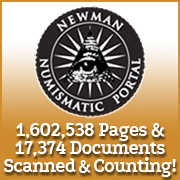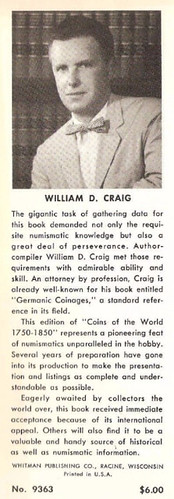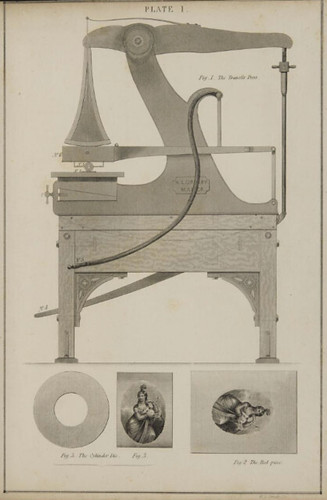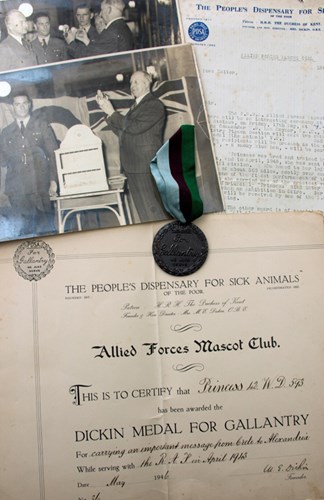
About UsThe Numismatic Bibliomania Society is a non-profit organization devoted to the study and enjoyment of numismatic literature. For more information please see our web site at coinbooks.org SubscriptionsThose wishing to become new E-Sylum subscribers (or wishing to Unsubscribe) can go to the following web page link MembershipThere is a membership application available on the web site Membership Application To join, print the application and return it with your check to the address printed on the application. Print/Digital membership is $40 to addresses in the U.S., and $60 elsewhere. A digital-only membership is available for $25. For those without web access, write to: Terry White, Treasurer AsylumFor Asylum mailing address changes and other membership questions, contact Terry at this email address: terrywhite5475@yahoo.com SubmissionsTo submit items for publication in The E-Sylum, just Reply to this message, or write to the Editor at this address: whomren@gmail.com BUY THE BOOK BEFORE THE COINSale Calendar |
- WAYNE'S WORDS: THE E-SYLUM DECEMBER 10, 2017
- KOLBE & FANNING’S 2018 NEW YORK CATALOGUE
- NEW BOOK: MEXICAN PAPER MONEY 2017 EDITION
- NEW BOOK: A COLLECTION IN CONTEXT
- OFFER: THE PRACTICAL BOOK OF COBS, 4TH EDITION
- NEWMAN PORTAL PARTNERS WITH DAVID LISOT
- DAVE HIRT'S 19TH CENTURY NUMISMATIC BOOKCASE
- WILLIAM DONAL CRAIG (1924-2014)
- NEWMAN PORTAL SEARCH: HUSTON
- THE SELLING OF INSTANT COLLECTIBLES
- NOTES FROM E-SYLUM READERS: DECEMBER 10, 2017
- MORE ON CYRUS FIELD MEDALS
- MORE ON MEDALLION ENGRAVING MACHINES
- VOCABULARY TERM: ANAGLYPTOGRAPHY, PART 2
- LEISER WOLF SCHNELLING (1897-1981)
- HARVEY STACK'S NUMISMATIC FAMILY, PART 6
- POLYMER RING COIN WINS IACA AWARD
- ROYAL MINT MUSEUM ACQUIRES HENRY VII TESTOON
- SAN FRANCISCO GOLD COINAGE IN 1857
- CNG TRITON XXI SALE HIGHLIGHTS
- STACK’S BOWERS OFFERS COLOMBIAN COINS AND PAPER
- ARCHIVES INTERNATIONAL SALE #46 SELECTIONS
- HEEGEMAN COLLECTION OF NEW ZEALAND TOKENS
- CHRISTMAS TOKENS
- CHRISTMAS TURKEY COINS
- THE HONG KONG PLAGUE MEDAL
- CARRIER PIGEON'S DICKIN MEDAL UP FOR SALE
- CRANE COMPANY BUYS CRANE CURRENCY
- KAZAKHSTAN NOTE DESIGNERS ACCUSED OF PLAGIARISM
- RABBI TELLS FOLLOWERS NOT TO LOOK AT BANKNOTE
- FEATURED WEB SITE: MEDALLIC ART IN FINLAND
Click here to access the complete archive
To comment or submit articles, reply to whomren@gmail.com
Content presented in The E-Sylum is not necessarily researched or independently fact-checked, and views expressed do not necessarily represent those of the Numismatic Bibliomania Society.
WAYNE'S WORDS: THE E-SYLUM DECEMBER 10, 2017
 New subscribers this week include: Jonathan Morowitz, courtesy of Pablo Hoffman; Ben Costello, Pat Flynn, J. Hernandez, Larry Hufnagel, Blaine Shiff, Robert Stakely, Rob Throckmorton, and
Pat Vetter. Welcome aboard! We now have 3,327 subscribers.
New subscribers this week include: Jonathan Morowitz, courtesy of Pablo Hoffman; Ben Costello, Pat Flynn, J. Hernandez, Larry Hufnagel, Blaine Shiff, Robert Stakely, Rob Throckmorton, and
Pat Vetter. Welcome aboard! We now have 3,327 subscribers.
Thank you for reading The E-Sylum. If you enjoy it, please send me the email addresses of friends you think may enjoy it as well and I'll send them a subscription with your compliments. Contact me at whomren@gmail.com anytime regarding your subscription, or questions, comments or suggestions about our content.
This week we open with a new catalogue from Kolbe & Fanning, two new books, an update from the Newman Numismatic Portal, and Dave Hirt's 19th century numismatic bookcase.
Other topics this week include author William Craig, Cyrus Field medals, medallion engraving, polymer ring coins, the Henry VII testoon, Christmas tokens, "turkey coins", Crane Currency and highlights of four upcoming auctions.
To learn more about the very rare plated W.H. Hunter sale, Karl von Schäffer's collection, 101 Ranch Round Up scrip, the U.S. Mint's quasquibicentennial, the Hong Kong Plague medal, the Guild of Medallic Art in Finland, and the Whore of Babylon and the chalice of poison and cruelty, read on. Have a great week, everyone!
Wayne Homren
Editor, The E-Sylum
KOLBE & FANNING’S 2018 NEW YORK CATALOGUE
KOLBE & FANNING’S 2018 NEW YORK BOOK AUCTION CATALOGUE NOW AVAILABLE
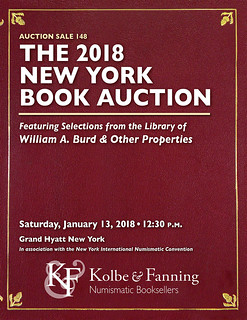 The catalogue for the 2018 New York Book Auction, to be held on Saturday, January 13, 2018 by Kolbe & Fanning Numismatic Booksellers, is now available through the firm’s online bidding
platform at bid.numislit.com. The catalogue, featuring highlights from the outstanding numismatic library formed by Chicagoan William A. Burd along with other properties, is also available through
the Kolbe & Fanning app, which can be downloaded from the Apple Store or Google Play Store. Printed catalogues have recently been mailed to active clients.
The catalogue for the 2018 New York Book Auction, to be held on Saturday, January 13, 2018 by Kolbe & Fanning Numismatic Booksellers, is now available through the firm’s online bidding
platform at bid.numislit.com. The catalogue, featuring highlights from the outstanding numismatic library formed by Chicagoan William A. Burd along with other properties, is also available through
the Kolbe & Fanning app, which can be downloaded from the Apple Store or Google Play Store. Printed catalogues have recently been mailed to active clients.
The sale will be held in conjunction with the New York International Numismatic Convention in the Empire State Ballroom I of the Grand Hyatt hotel in Manhattan (109 E. 42nd Street), beginning at 12:30 pm Eastern Time.
A few highlights include:
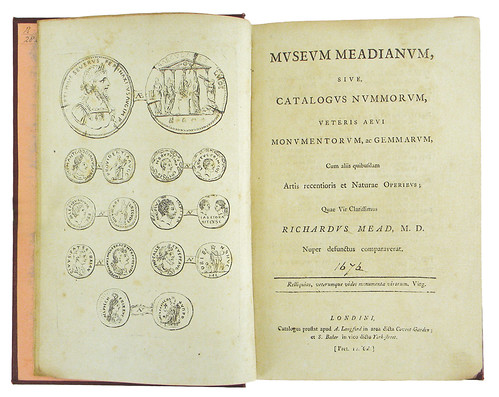
Lot 13
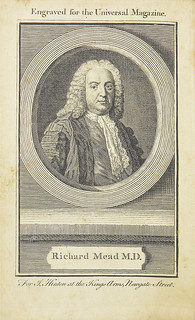

Lots 13 and 33
Lot 13: the 1755 auction catalogue of the Richard Mead collection, priced & named
Lot 33: an attractive original copy of Cohen’s classic work on Roman Republican coins

Lot 51
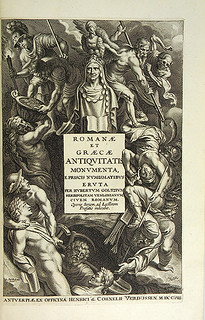
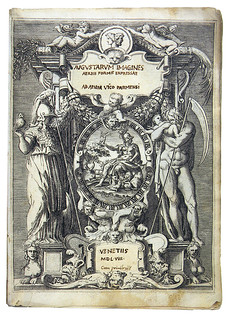
Lots 51 and 130
Lot 51: the impressive 1708 five-volume folio edition of Goltzius, including the magnificent Icones volume
Lot 130: a unique printer’s mock-up of Aeneas Vico’s 1558 Augustarum Imagines


Lots 211 and 255
Lot 211: an original copy of Hutten-Czapski on early Russian coins
Lot 255: an extraordinary suite of 285 original drawings of Lyonnaise jetons from the collection of Ernest Poncet
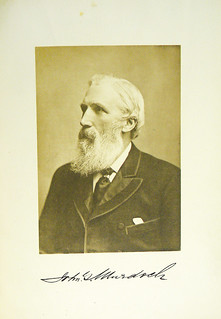
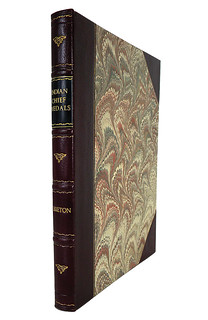
Lots 288 and 334
Lot 288: the complete Sotheby’s sales of the John G. Murdoch collection (1903-04)
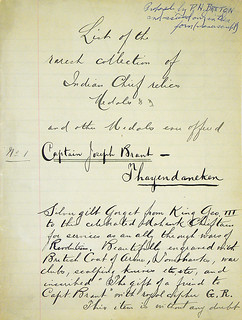
Lot 334
Lot 334: P.N. Breton’s very rare handwritten catalogue of Indian Chief Medals
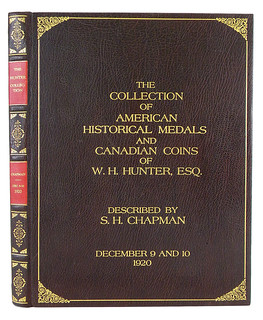
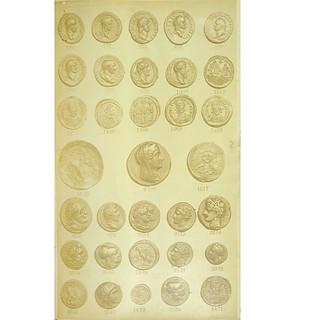
Lots 344 and 374
Lot 344: a beautiful copy of the very rare plated W.H. Hunter sale (S.H. Chapman, 1920)
Lot 374: the exceptionally rare plated Schieffelin catalogue of ancient coins (Scott & Co., 1879), bound with 34 other sales from that year, ex the Virgil Brand library.
Bids may be placed via post, email, fax or phone, as well as online. To register for the sale online, bidders must go to bid.numislit.com and register or sign in. Once you have set up an account, you may browse lots, place advance bids, or participate in the live sale online.
Bids placed via post, fax, or to the Gahanna office phone must be received by Monday, January 8, in order for them to be processed. Emailed bids and calls to David Fanning will be accepted through Friday, January 12. Advance absentee bids may be placed anytime online at bid.numislit.com; live internet bidding will be available during the sale itself through the same platform.
Kolbe & Fanning Numismatic Booksellers LLC is a licensed and bonded auction firm in the State of Ohio. For more information, please see the Kolbe & Fanning website at numislit.com or email David Fanning at df@numislit.com. To register for the sale, go to bid.numislit.com. We look forward to your participation.
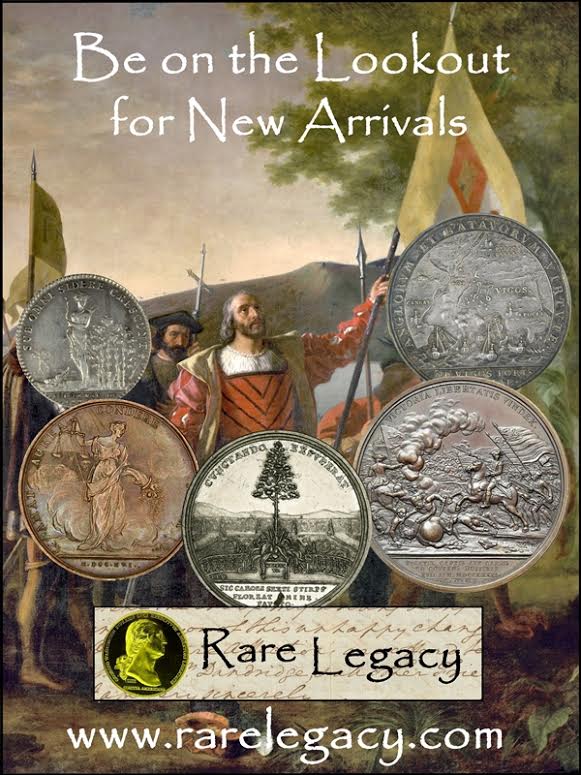
NEW BOOK: MEXICAN PAPER MONEY 2017 EDITION
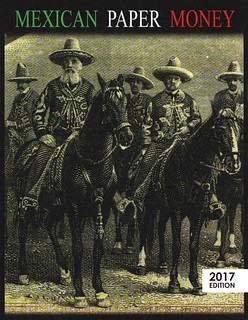 MEXICAN PAPER MONEY NEW EDITION!
MEXICAN PAPER MONEY NEW EDITION!
2017 Edition
We are proud to release the 2017 Edition of the most complete guide to Mexican Paper Money ever published. Mexican Paper Money has become the industry standard and contains listings on more than 7,000 items of which thousands are not listed in many catalogs.
The 2017 Mexican Paper Money digital download should be used in conjunction with the latest version of Adobe Acrobat Reader, which can be downloaded free on the Adobe website get.adobe.com.
This version of Mexican Paper Money is fully searchable using Adobe Reader. You can search for a specific word, an M number or anything else. The search window pops up when you open Adobe Reader. Further, the Table of Contents following this introduction section has links to the corresponding section in the book. For instance, you can click on Aguascalientes under Bancos and it will take you directly to that section.
2010 Hardcover Book Edition
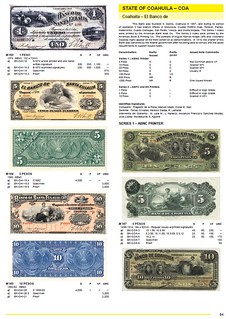 The 2010 hard cover edition consists of 400 pages printed in full color on over sized paper. We will ship it to you for FREE!
The 2010 hard cover edition consists of 400 pages printed in full color on over sized paper. We will ship it to you for FREE!
2500 COLOR IMAGES
HUNDREDS OF NEW LISTINGS
OVER 400 PAGES
7000+ items
For more information, or to order, see:
Mexican Paper Money 2017 Book (https://worldnumismatics.com/product/mexican-paper-money-2017-book/)
NEW BOOK: A COLLECTION IN CONTEXT
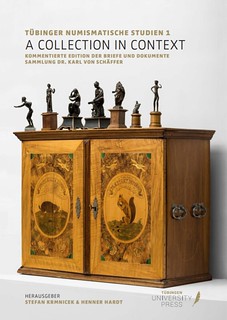 A collection in context. Annotated edition of the letters and documents Karl von Schäffer
A collection in context. Annotated edition of the letters and documents Karl von Schäffer
Krmnicek, Stefan (ed.) ; Hardt, Henner (ed.)
Document: Book (monograph)
Date: 2017
Language: German
Faculty: 5 Faculty of Arts
Department: Classical archeology
DDC classification: 930 - History of ancient world to about 499
Keywords: Numismatics, Coin Collection, Eberhard Karls University Tübingen, Classical Archeology
ISBN: 978-3-947251-01-8
License: Creative Commons Attribution, Non Commercial,
No Derivatives
Summary of Contents:
Tuebingen Numismatic Studies 1
The first volume of the Tübingen Numismatic Studies series examines Karl von Schäffer's collection of just under 3000 numismatic objects, which came into the possession of the University of Tübingen as a legacy in 1888, in its context of scientific history. The edition of the complete collection documentation becomes by contributions to the university collection history, a biographical-psychological analysis of the person Karl of Schäffer, studies to the coin trade and to the collection and exploration of coins in the 19. Century as well by a detailed investigation to the networks of the antique and coin-interested Bildungsbürgergertums evaluated in the Kingdom of Württemberg
For more information, or to download, see:
A collection in context. Annotated edition of the letters and documents Karl von Schäffer
(https://publikationen.uni-tuebingen.de/xmlui/handle/10900/78001)

OFFER: THE PRACTICAL BOOK OF COBS, 4TH EDITION
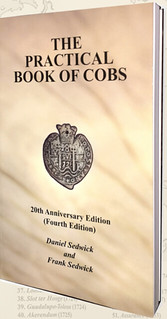 The Practical Book of Cobs is a reference book on Spanish colonial coins by Daniel Sedwick and Frank Sedwick. First published in 1987, the book has been re-released three times, most
recently in a 20th Anniversary edition (4th edition) published in 2007
The Practical Book of Cobs is a reference book on Spanish colonial coins by Daniel Sedwick and Frank Sedwick. First published in 1987, the book has been re-released three times, most
recently in a 20th Anniversary edition (4th edition) published in 2007
An essential guide and reference work for divers and shipwreck enthusiasts, this book offers information that is not readily available or only available after searching many reference works or auction catalogs.
This book covers the mints, assayers, styles, and types of “treasure coins” from the period 1536 at the Mexico City Mint until 1773, the end of cob-type coins minted at the Potosí Mint in Bolivia. In addition it has a section that goes over each of the most famous treasure wrecks of all time including the Atocha, the Spanish 1715 Fleet and many others.
Reviews:
Joe Lasser, The E-Sylum: Volume 10, Number 36, September 10, 2007, Article 2:
"Dan Sedwick has produced a fourth edition of The Practical Book of Cobs. In it he has carefully revised and enlarged assayer descriptions and very importantly for any and all researchers, he explains the rationale for his conclusions. He's added a new section giving a list of fifty-five treasure ships and their cargoes and has compressed virtually every important fact known about cobs today into this well structured volume. It is well written—lucid and logical—and is a meaningful addition to cob coin literature that should be included in everyone's library. I wish that I could do as good a job as Dan has done."
Ernest Richards, PLUS VLTRA Newsletter: Enrada Publications, October 2007:
“This popular book has been out of print since 1995 and unavailable for a number of years now, so this [fourth] edition should be a most welcome addition to the market! Greatly expanded from the previous edition (more than 100 pages longer!), this 20th Anniversary Edition contains a long new section on the shipwrecks that have yielded cobs over the years, complete with a foldout map and specified bibliographies for each wreck. Also, the assayer section incorporates the latest research information, with specimen photos of most of the assayers (not separated into a photo section as before). The values in the back, of course, have been updated. What has not changed, however, is the appeal to both beginners and advanced collectors alike, as well as dealers and jewelers who work with cobs. The Practical Book of Cobs offers readers a look at the following topics: Historical background / Elements of design / Market values / Extensive bibliography / Complete ID of mint marks, assayers, and period / How cobs were made and used / Treasure Fleets and other shipwrecks that produced cobs / How to buy and sell, and how to spot counterfeits.”
· Bidding: Paperback, perfect bound, 8½" x 5½"
· Pages: 254
· Edition: 4th edition (July 1, 2007)
· Publisher: Daniel Frank Sedwick, LLC,
· Location: Winter Park, FL, USA
· Language: English
· Illustration: Illustrated throughout (b/w)
· ISBN: 0982081804
· ISBN-13: 9780982081808
For more information, or to order, see:
Sedwick's Practical Book of Cobs Spanish Colonial Coins & Shipwreck
Reference (https://www.ebay.com/itm/Sedwicks-Practical-Book-of-Cobs-Spanish-Colonial-Coins-Shipwreck-Reference/132424593271)

NEWMAN PORTAL PARTNERS WITH DAVID LISOT
Newman Numismatic Portal Partners with David Lisot
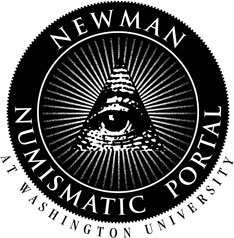 The Newman Numismatic Portal (NewmanPortal.org), an online repository for American numismatic research, has concluded an agreement with David Lisot that will make available the extensive
archive of the David Lisot Numismatic Video Library dating back to the 1980s. David Lisot, current CoinTelevision.com president, has been recording presentations at the largest and most important
numismatic trade shows for more than 30 years. He has created nearly 2,000 different videos over the course of his career, covering hundreds of speakers and topics. This extensive catalog will be
posted to the Newman Portal over the course of the next 12 months, giving users the opportunity to freely access the expertise of leading hobby figures. Lisot will further maintain a presence at
numismatic shows going forward and deliver video coverage of current events as official videographer on behalf of the Newman Portal.
The Newman Numismatic Portal (NewmanPortal.org), an online repository for American numismatic research, has concluded an agreement with David Lisot that will make available the extensive
archive of the David Lisot Numismatic Video Library dating back to the 1980s. David Lisot, current CoinTelevision.com president, has been recording presentations at the largest and most important
numismatic trade shows for more than 30 years. He has created nearly 2,000 different videos over the course of his career, covering hundreds of speakers and topics. This extensive catalog will be
posted to the Newman Portal over the course of the next 12 months, giving users the opportunity to freely access the expertise of leading hobby figures. Lisot will further maintain a presence at
numismatic shows going forward and deliver video coverage of current events as official videographer on behalf of the Newman Portal.
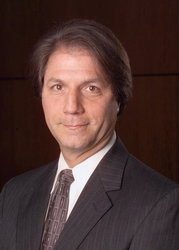 Lisot’s background in video production began with television in 1986 when he began hosting the “Coin Report”, a live daily national news segment, for the Financial News Network. Lisot’s
passion for numismatics inspired him to begin videotaping coin conventions in 1988 for groups like the American Numismatic Association, Florida United Numismatists, and the National Silver Dollar
Roundtable. Since then he established himself with most major numismatic trade shows and organizations where educational seminars take place both nationally and internationally.
Lisot’s background in video production began with television in 1986 when he began hosting the “Coin Report”, a live daily national news segment, for the Financial News Network. Lisot’s
passion for numismatics inspired him to begin videotaping coin conventions in 1988 for groups like the American Numismatic Association, Florida United Numismatists, and the National Silver Dollar
Roundtable. Since then he established himself with most major numismatic trade shows and organizations where educational seminars take place both nationally and internationally.
David Lisot, CoinTelevision.com president, commented “I am excited to be part of the Newman Portal team and to share this unique archive with the wider numismatic community. Today’s technologies allow for distribution of this content to a larger audience not imagined a generation ago.”
Len Augsburger, Project Coordinator for the Newman Portal, added “The David Lisot Numismatic Library archive is a one-of- a-kind record of American numismatics from the 1980s to recent times, and we look forward to allowing our users to virtually connect with this wide array of numismatic speakers of the past and present. Video creates a special connection between viewer and subject, adding a new dimension to the considerable written record already available through the Newman Portal.”
The Newman Portal, administered through Washington University in St. Louis, was established in November 2014 through a grant from the Eric P. Newman Numismatic Education Society. The Portal currently contains over 18,000 freely accessible documents, with an emphasis on American numismatics.
To visit the Newman Numismatic Portal, see:
https://nnp.wustl.edu/
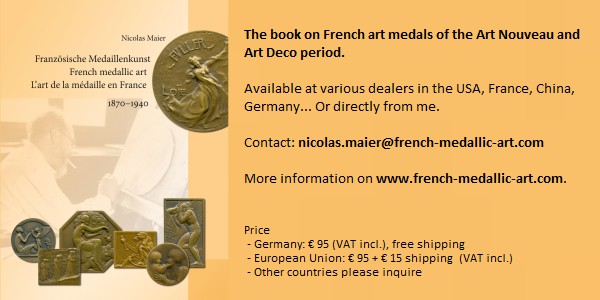
DAVE HIRT'S 19TH CENTURY NUMISMATIC BOOKCASE
Dave Hirt writes:
I wanted to organize a 19th bookcase as well. Here are the results. Of course the Coins of New Jersey book is too big, so that is on the separate picture. I was pleased with the result.
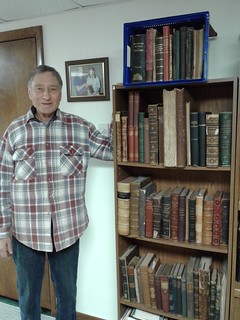

To read the earlier E-Sylum article, see:
ASYLUM WINTER 2017 ISSUE PUBLISHED (http://www.coinbooks.org/v20/club_nbs_esylum_v20n48.html#article2)
WILLIAM DONAL CRAIG (1924-2014)
Last week contributor Paul Withers of Galata Coins wondered if numismatic author William D. Craig was still with us. Sadly, he passed away a few years ago at the age of 90. Ron Haller-Williams writes:
It seems that W D Craig was younger than your sources had indicated. (These were "born about 1920" and "95 years old in Feb.2014".) He died on 12-Mar-2014, after consigning his collection to Downies but nearly four months before the auction.
William Donal "Bill" Craig was an American-born Australian numismatist, philatelist, and attorney. He is most notable for authoring the popular Coins of the World 1750–1850 and various philatelic publications.
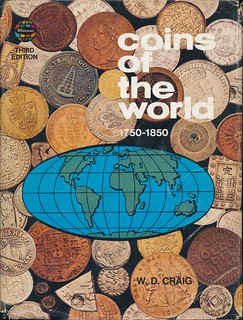 At some point, Craig developed an interest in coins, particularly those of Germanic origin. His first work, Germanic coinages (Charlemagne through Wilhelm II), focused on this area
of study, and was privately published in 1954. It was followed in 1966 by the first edition of Coins of the World 1750–1850, which was split into two volumes: Coins of the Western World and
Coins of Africa and Asia. In 1971 both of these volumes were consolidated into one large second edition, which was followed by a third edition in 1976. The Standard Catalog of World Coins,
which has since largely replaced Coins of the World 1750–1850, currently includes some catalog numbers from Craig's work, denoted by a C# prefix. Having also acquired an interest in
Australian revenue stamps, Craig published nine catalogs on the subject from 1978 to 1999.
At some point, Craig developed an interest in coins, particularly those of Germanic origin. His first work, Germanic coinages (Charlemagne through Wilhelm II), focused on this area
of study, and was privately published in 1954. It was followed in 1966 by the first edition of Coins of the World 1750–1850, which was split into two volumes: Coins of the Western World and
Coins of Africa and Asia. In 1971 both of these volumes were consolidated into one large second edition, which was followed by a third edition in 1976. The Standard Catalog of World Coins,
which has since largely replaced Coins of the World 1750–1850, currently includes some catalog numbers from Craig's work, denoted by a C# prefix. Having also acquired an interest in
Australian revenue stamps, Craig published nine catalogs on the subject from 1978 to 1999.
Before his death in 2014, Craig consigned his collection to the Australian auction company Downies. It was sold as part of Downies auction 317, which took place during July 2014.
To read the complete Wikia article, see:
William D. Craig (http://currencies.wikia.com/wiki/William_D._Craig)
This article shows him as one of the "73 Cadets Receive Their Degrees At Marmion June 14" (Observer, June 14, 1942)
To read the complete article, see:
73 Cadets Receive Their Degrees At Marmion June 14 (http://obs.stparchive.com/Archive/OBS/
OBS06141942p04.php)
When young William Donal was also at Annapolis Naval Academy in 1943, he looked up the Baum family in Washington DC and met the 15 yo Alexandra Porter about to depart with her date- apparently Bill decided he was going to make it difficult for the 16 year old date- placed himself on the couch and kept them in conversation...
They began a young relationship - one that blossomed over two continents and spanned the next three years, culminating in their marriage on December 28, 1946 at Treasure Island Chapel in San Francisco Bay.
To read the complete article, see:
For the Oz family Craig- our U.S. history. (http://ozcraigshistory.blogspot.co.uk/2015/05/welcome-to-u_32.html)
Ron adds:
One clarification: The 1966 edition of CoTW has both “parts” (NOT “volumes”) bound as one - “Coins of the Western World” occupies pages 1-593, and “Coins of Africa and Asia” occupies pages 594-747, with a shared "index and finding list on pp 748-753. The “large second edition” of 1971 was larger format but fewer pages.
David T. Alexander writes:
It was great to see the appreciation of William D. Craig and "Germanic Coinages." This title was among the first "foreign" coin titles I obtained as a 14 year-old collector in Miami, Florida. We were lucky to have a brand-new public library that offered four shelves of CIRCULATING coin books as well The Numismatist and Numismatic Scrapbook in the reference library. We also had a full time dealer of mature years, the late Frederick A. Newman, NUMISMATIST, PHILATELIST as was emblazoned in gold leaf on his massive safe. Newman was a survivor of the 1930's U.S. commemorative coin boom. He also sold books, including Craig's remarkable work.
A few years later, I saw Craig's series of poignant ads in Scrapbook headed LAST CHANCE TO OBTAIN GERMANIC COINAGES at a close-out price. These tiny ads radiated disappointment and almost belligerent regret, offered his book at something like $5.00 "to tide me over the last months of penury before I enter real estate..." Seemingly he had anticipated lively book sales that would have supported himself and his family, but these never eventuated.
Perhaps on a more upbeat note, Pat and I celebrated our 40th wedding anniversary December 3. Even this has a numismatic sidebar, as we spent our honeymoon at the New York International Numismatic Convention at the Americana Hotel, Seventh Avenue and 55th Street, covering the convention for Coin World!
See also:
CRAIG, WILLIAM DONAL (http://obituaries.themercury.com.au/notice/29532001)
William Donal Craig grave monument in Public Cemetery, Gisborne, Victoria, Australia
(http://www.gravestonephotos.com/public/gravedetails.php?grave=491617&scrwidth=1440)
To read the earlier E-Sylum articles, see:
DIRTY OLD BOOKS: CRAIG’S GERMANIC COINAGES (http://www.coinbooks.org/v20/esylum_v20n50a05.html)
DOWNIES TO SELL WILLIAM D. CRAIG COLLECTION (http://www.coinbooks.org/esylum_v17n10a09.html)
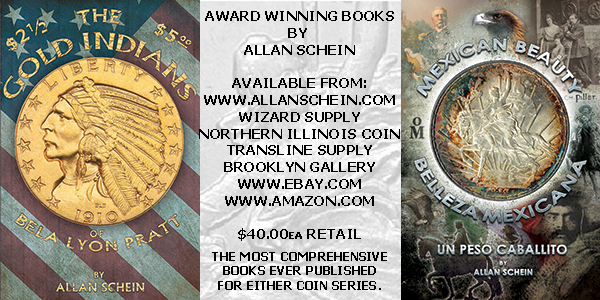
NEWMAN PORTAL SEARCH: HUSTON
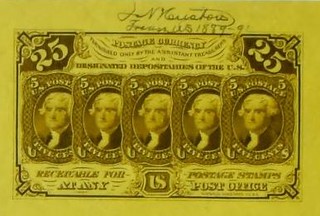
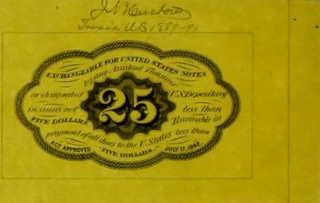
The term “Huston” was entered in the Newman Portal this week, and it’s not a typo for “Houston.” Huston refers to James N. Huston, U.S. Treasurer from 1889-1891. Huston (1849-1927) was a prominent businessman and politician from Indiana who was ultimately convicted of mail fraud in connection with his activities at the National Trust Company. Scandal is timeless, even if it seems especially active in the current culture. From a numismatic perspective, Huston is best remembered for a series of fractional and postage currency specimen pairs bearing his courtesy autograph. These were featured in the Ford XIX sale (10/2007), beginning with lot 846, there described as ex. F. C. C. Boyd. Illustrated here is lot 847, an example of 25-cent postage currency (Friedberg-1282SP), signed by Huston. Certain of these reappeared in Stack’s sale of the Berngard collection (7/2008).
Link to Stack’s Ford XIX sale on Newman Portal:
https://nnp.wustl.edu/library/auctionlots?AucCoId=3&AuctionId=515271&page=245
Link to Stack’s Berngard sale catalog
https://nnp.wustl.edu/library/auctionlots?AucCoId=3&AuctionId=517002&page=303
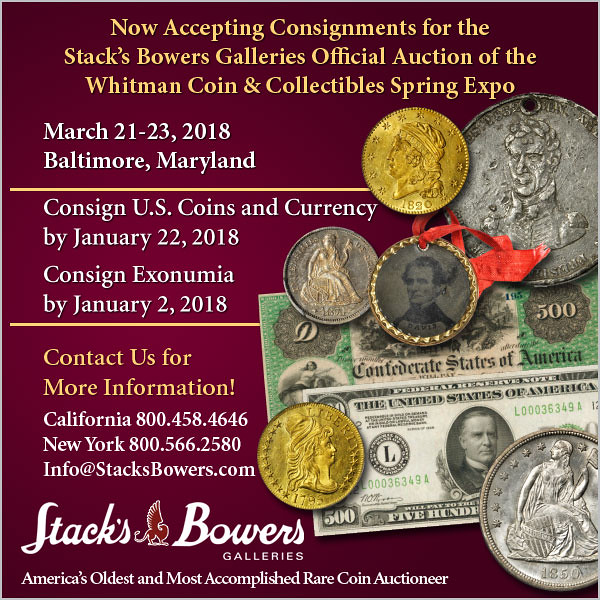
THE SELLING OF INSTANT COLLECTIBLES
The article on how the minting of collector items has its sad stories here in Spain as well. I had an opportunity to buy an entire silver coin series of the 500th anniversary of Spain’s encounter with the Americas. The retired fellow who had diligently purchased all of these handsomely packaged pieces in the 1990s knew he had to face the fact that for all those years he had not been investing in coins, only collecting them. These are Spain’s moneda-medalla pieces. That word, obviously meaning coin-medals, is a Madrid mint’s profit center just like our cumbersome NCLT — Non Circulating Legal Tender.
Felix was ready to sell his collection. His now-adult kids showed no interest in the ‘coins’ so he turned to a mutual good friend, a jeweler, to find a home for them. I checked with two coin dealers here to determine how I could buy these beautiful not-quite-coins for a fair price. I am willing to pay a bit more than a dealer would give him. They both gave me the same advice.
I asked the most seasoned dealer to visit my home. I opened my 2012 Standard Catalog of World Coins 1901-2000 to the Spain listings. The first of the coins I wanted was KM 841 (The huge book does not have page numbers!), one of the series of .925 fine sterling pieces illustrated in the catalog. The mintage varied from 7,000 to 47,000 for the giant 10,000 peseta pieces and catalog values ranged from $165 to $275.
“What should I be paying for these — 40% off retail?” I asked my dealer friend. “No — Melt” was the dealer’s stern answer. Wow — that means those big five ounce pieces were worth only $80 each in silver. Translating the peseta price tags still on the packages, that meant that my new friend had paid about $120 in the 1990s for each piece. I am still waiting to hear from Felix. I imagine he struggles with taking a loss on these pieces. As I feel for the seller, I am also not doing much for myself as an investment. Silver has hung around its current price for quite a while. I would be gambling that it will go up and not down when I buy these NCLT pieces.
Editor Wayne said last week: “Educate me, readers — we don't ordinarily cover topics such as pricing and investment.” OK — Numismatics as I have lived it has always been collecting linked to smart coin buying and an eye on investment. That worked for me. I sold most of my 1960s era collection (when I was a high school and college kid) in the late 1970s (when I was back in San Diego after six years in the USAF) to help me buy a small office building for my new advertising agency. I miss those great coins, but one office building led to another and we now live in Spain thanks to leasing a building worth about $800,000. Those coins sold in the 1970s produced about $5,000 but that was a key part of launching my business.
The loss to Felix in just straight dollar (or euro) amounts is annoying enough. The relative value or standard of living value of that $120.00 purchase from 1990 today ranges from $220.00 to $374.00. The higher amount represents the economic status value or the economic power value of the purchase after 27 years or so.
A couple of other terms for the current $200 value of the purchase are particularly ironic: These are called the historic opportunity cost or the contemporary opportunity cost. What that mint product did not deliver in any way was an opportunity. The buys Felix made in the 1990s were a fun hobby but a crappy investment no matter how you look at it.
There is a passion in many people to collect things. This can be as silly as sugar packets to as sophisticated as ancient coins or patterns made by the U.S. Mint. We see Hummel figurines, original edition Ford Mustangs, Cabbage Patch Dolls, Pet Rocks and, of course, coins and things that look like coins. Some people collect, some hoard and some suffer from obsessive compulsive disorders (OCD).
Having owned an advertising agency during 30 years back in San Diego, I study the messaging the mints use. They want to touch on aspects of value in their promotion, yet they know that ads are an implied warrantee of products so the writing carefully walks the line.
Typical mint advertising messages: “Don’t miss this opportunity to add these limited edition products to your collection before they go off sale forever.” This classic manipulative advertising line appears on the website speaking to the most ignorant of American shoppers. It leaves the impression that if you fail to take action and buy these items they will become difficult to find and their price will go up. History shows us that such is not the case. The word ‘coin’ is used extensively on the mint’s website. Legally they are coins because you could spend a one ounce silver piece for a dollar as you ignore it holding $17 in silver. Got ya!
The mints might rationalize this situation this way: “You have years of pleasure with these items. If you were a golfer and quit playing you might get 20% of what you paid for clubs and gear. It is just a hobby. Your country has made money off of you, so — thanks.
On the topic of Silver Bullion Coins the mint’s website tells you that these round one troy ounce ingots “provide investors with a convenient and cost effective way to add silver to their investment portfolio” while disclaiming that “Pricing for bullion coins typically depends on the market price of the metal.” The mint steps further away from this issue by not selling such items directly to consumers. You are told: “Visit the [on-line] Bullion Dealer locator to locate a dealer — bullion coins are not sold directly by the U.S. Mint.”
No discussion of mints conduct regarding NCLT is complete without mentioning the Franklin Mint, that benchmark of collector scams since 1964. It is still alive, exploiting that unending desire to collect things. It is turning out items of no numismatic importance whatsoever, such as colorized $2 bills featuring such themes as Star Trek, Elvis and President Trump. You can also buy on its website a half pound of ‘wheatback pennies,’ WWII cent sets, and the last Franklin silver half dollar. A look at the Wikipedia website for Franklin Mint is a fascinating look at how businesses can pander to and exploit the ignorance of many driven to collect things.

NOTES FROM E-SYLUM READERS: DECEMBER 10, 2017
101 Ranch Round Up Scrip

I’m surprised you didn’t include a picture of the 1924 “Round Up” scrip put out by the 101 Ranch (I’ve included a link to a routine, and overpriced, eBay listing). I see samples of this stuff in antique shops around Oklahoma City. Histories of the ranch mention in passing the existence of scrip, but I’ve never found any details about its issue.
Though little remains physically of the 101 Ranch, its records are archived in the Western History Collections at the University of Oklahoma. I once took a look through the archives regarding the scrip. Alas, apart from finding one folder full of the scrip itself, I found no further clues about its use. I have seen 101 Ranch coins as well.
Given the high denominations and the relatively elaborate devices, I suspect these notes were issued/sold as souvenirs to visitors, and not actually used by Ranch employees.
To read the complete lot description, see:
OKLAHOMA, PONCA CITY - AUTHENTIC PMG 58 MILLER BROTHERS 101 RANCH - 5 BUCKS
(https://www.ebay.com/itm/OKLAHOMA-PONCA-CITY-AUTHENTIC-PMG-58-MILLER-BROTHERS-101-RANCH-5-BUCKS/172916608045)
To read the earlier E-Sylum article, see:
NEWMAN PORTAL SEARCH: 101 RANCH (http://www.coinbooks.org/v20/esylum_v20n50a08.html)
Bela, Meet Bela
Alan Weinberg writes:
Have you noticed the remarkable resemblance of Bela Lyon Pratt to a young circa 1931 Bela Lugosi?
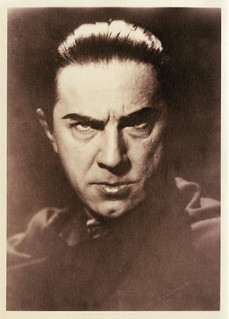
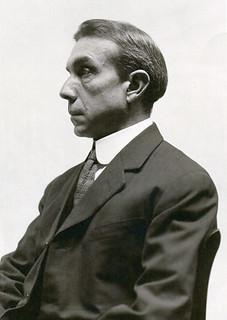
To read the earlier E-Sylum article, see:
THE BELA LYON PRATT SESQUICENTENNIAL (http://www.coinbooks.org/v20/esylum_v20n50a17.html)
What Do You Call a 225-Year Anniversary?
Last week I asked:
If a 100-year anniversary is a Centenniel, a 125-year is a Quasquicentennial, a 150 year is a Sesquicentennial and a 200-year is a Bicentennial, what is a 225-year anniversary called?
Pete Smith writes:
The best name for a 225th anniversary is probably Quasquibicentennial. There is also a reference to Bicentquasquigenary which is probably composed of the right pieces but not widely used.
Ron Haller-Williams writes:
For the 225-year anniversary I'll offer "Quastercentennial". Unfortunately, it's confusingly close to Quatercentennial = 400th !!! (Does that make the "s" is worth "-175"?)
To read the complete Wikipedia article, see: Anniversary names : Latin-derived numerical names (https://en.wikipedia.org/wiki/Anniversary#Latin-derived_numerical_names)
To read the earlier E-Sylum articles, see:
VOCABULARY ANSWER: QUASQUICENTENNIAL (http://www.coinbooks.org/esylum_v04n08a08.html)
NOTES FROM E-SYLUM READERS: DECEMBER 3, 2017 : 225 Years of the United States Mint
(http://www.coinbooks.org/v20/esylum_v20n50a12.html)
The Other Nickels in the 1913 Liberty Nickel Case
Regarding the recently-sold eight-slot holder which once held the five original 1913 Liberty Nickels, last week I asked:
What coins once resided in the other three slots? Where are they now?
Pete Smith cited this May 14, 2006 E-Sylum response from Howard Spindel:
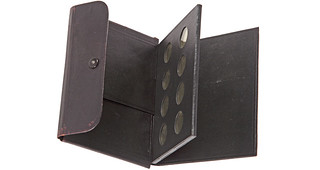 "My reference library tells me that the three other coins originally present with the five 1913 Liberty nickels were three Buffalo nickels - one Judd 1790 pattern, one type 1, and one
type 2. 1942 was the last time all eight coins were together in one holder, owned by Eric P. Newman.
"My reference library tells me that the three other coins originally present with the five 1913 Liberty nickels were three Buffalo nickels - one Judd 1790 pattern, one type 1, and one
type 2. 1942 was the last time all eight coins were together in one holder, owned by Eric P. Newman.
As to where all the Buffalos are now, my library doesn't say. As of 1969, two of them were apparently still in Newman's hands."
Pete Smith adds:
The 2006 answer about three other coins in the 1913 nickel holder mentions the 1913 pattern Judd-1790 struck in copper. This has now been discredited as a regular issue plated in copper. It was last reported in Eric Newman's collection. I have not seen a record of its sale. Perhaps Eric took it with him.
To read the earlier E-Sylum articles, see:
QUIZ ANSWER: THE OTHER NICKELS IN THE 1913 LIBERTY NICKEL CASE (http://www.coinbooks.org/esylum_v09n20a22.html)
1913 LIBERTY NICKEL HOLDER BRINGS $10,800 (http://www.coinbooks.org/v20/esylum_v20n50a22.html)
World's Largest Chocolate Kennedy Half?
Bruce Perdue writes:
Here is a one pound chocolate Kennedy half. I saw it at Menards, a Midwest home improvement store.

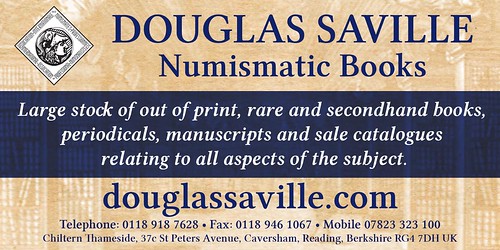
MORE ON CYRUS FIELD MEDALS
The 1868 Cyrus Field Congressional Gold Medal


The 1858 Cyrus Field Atlantic Telegraph Cable Medal
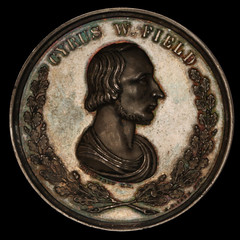
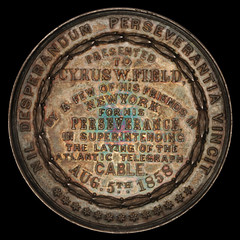
To read the earlier E-Sylum articles, see:
THE CYRUS FIELD MEDAL (http://www.coinbooks.org/esylum_v19n46a23.html)
THE 1868 CYRUS FIELD CONGRESSIONAL GOLD MEDAL (http://www.coinbooks.org/v20/esylum_v20n50a24.html)
To view the images on the Newman Portal, see:
Cyrus W. Field Atlantic Telegraph Cable Medal (obverse) (https://nnp.wustl.edu/library/imagedetail/510565)
Cyrus W. Field Atlantic Telegraph Cable Medal (reverse) (https://nnp.wustl.edu/library/imagedetail/510566)

MORE ON MEDALLION ENGRAVING MACHINES
From the The Ephemera Society of America:
As a tracing arm moves over an original dimensional item (coin, bas-relief portrait, plaster model of a medal or a frame, even a sculpture), linkage to a graver reproduces the contours of the original as a continuous-line engraving. Vertical differences in the original are translated into horizontal differences (contours) in the engraving. The engraved reproduction plate is similar to a contour map, and when inked gives the strong illusion that the object is embossed.
PLATE 1: The Transfer Press
The Transfer Press.
Figure One. - The Transfer Press, represented in a position to take up in relief, on a cylinder die, the engraving on the bed-piece.
Number Two - The bed-piece, which is case-hardened.
Number Three - The steel cylinder, which has been made soft by annealing.
Number Four - The foot lever; by means of which the cylinder is pressed upon the bed-piece.
Number Five - The hand lever, which forces the beam (number six) backward and forward.
Number Six - The beam, which has a motion backward and forward.
Number Seven - The screw, for elevating and depressing the bed of the machine.
Figure Two. — The engraved bed-piece. — The vignette upon it is produced by concave lines cut into the steel by the hand and implements of the Artist.
Figure Three. - A side and front view of the cylinder die. The vignette upon it is produced by pressure upon the bed-piece. The lines, of course, are convex, and after the dies have been case- hardened, are readily transferred again in any required spot in a Bank Plate.
It will be seen that only one half of the cylinder can be used to take up the engraving, as here represented ; but an arbor, or mandrel, may be employed in a manner which will permit the engravings to be taken up on the entire periphery of the cylinder.
The honor of the invention of this method of transferring engravings from one piece of steel to another, belongs to our distinguished countryman, Jacob Perkins, whose portrait may be seen on Plate Ten, Figure Ten.
Transfer Presses have been made in various ways. The one represented in the engraving is, we believe, the best, and is the invention of our ingenious fellow citizen, James Bogardus, Esq. The writer has constructed one of these presses for Mr. Wellstood; one for Messrs. Rawdon, Wright, and Hatch, the well-known Bank Note Engravers, of this city ; and is now constructing one for his own use. The cost of such a press is about five hundred dollars.
PLATE TWO: The Ruling, and Medallion Machines

The Ruling, and Medallion Machines.
Figure One. - The Friction Ruling Machine, in common use among Engravers. It is represented in a position to execute straight lines. By the application of a brass rule, having an indented edge, waved lines can also be executed by the same machine.
Number One - The sliding carriage, which has a motion backward and forward. The use of this is to mark parallel lines, with the diamond point, through an etching ground, on the Plate.
Number Two - represents the plate as placed upon the bed of the machine, which has a lateral motion. The diamond point is represented as resting upon the plate.
Number Three - The index, to regulate the width of the lines.
Number Four - The connecting bar.
Figure Two. - The Medal Copying Machine, which is made precisely like the plain ruling machine, with the exception of the four upright supporters of the medal, and a very simple tracing apparatus, which is attached to the carriage.
Number One - The supporters of the medal.
Number Two - The medal in a horizontal position, with the face downwards.
Number Three - The steel point tracer; the uneven motion of which, in passing over the medal, conveys a corresponding lateral motion to the diamond point in passing over the surface of the plate.
The medal, which is being copied, and the plate, are moved along together, by means of the index, and connecting bar.
There are many kinds of ruling machines, some of which are very ingenious and complicated. Those represented in the engraving, are substantially the invention of the writer. Their simplicity and accuracy are generally commended.
The writer has another machine in actual use, which is wound up like a clock, and is made to propel the ruling machine for several hours without the personal attention of any one. The weight employed is about three hundred pounds, and the fall, sixty feet.
To read the complete book on the Newman Numismatic Portal, see: Ormsby's Bank Note Engraving (https://nnp.wustl.edu/library/book/522939)
To read the earlier E-Sylum articles, see:
MEDAL-ENGRAVING MACHINES AND ANAGLYPTOGRAPY (http://www.coinbooks.org/v20/esylum_v20n50a14.html)
VOCABULARY TERM: ANAGLYPTOGRAPHY (http://www.coinbooks.org/v20/esylum_v20n50a15.html)

VOCABULARY TERM: ANAGLYPTOGRAPHY, PART 2
ANAGLYPTOGRAPHY. I teased you last week by asking who won the court battle over the use of their anaglyptographic process to illustrate the book of British medals, the English or the French. Also what Mint Engraver was involved.
The answers are the French publisher and Mint Engraver William Wyon. Here is the complete history and the outcome after the court ruling.
History of the anaglyptograph.
The medallic engraving machine was based on early 19th century models of the ruling pen and a mechanical contrivance, the Collard engraving machine, used for watch case and snuff box decoration (by FLAT ENGRAVING). In Philadelphia in 1817, Christian Gobrecht (1785-1844), developed the first successful, but primitive, medallic engraving device, even though he had been an engraver for only seven years, a craft he had taken up as a 25-year old watchmaker apprentice in Lancaster County Pennsylvania.
In 1818 Gobrecht had a fellow Philadelphian build for him a somewhat more refined machine. This was accomplished by Joseph Saxton (1790-1873), a machinist, inventor, and later, constructor of weighing equipment for the U.S. Mint. Little was done with the machine for a decade, but Saxton did take it with him to London and improved upon it there in 1829.
Meanwhile, an American artist and banknote engraver, Asa Spencer (ca 1805-?), had built one or more machines, based on Gobrecht’s design, and sent engravings to London. A gentleman there purchased one of Spencer’s machines, and, upon the gentleman’s death, it passed to a technician in London, John Bate. Little is known of Bate, who is described only as “optician to the admiralty,” but he is to play an important role in the story of the anaglyptograph.
Bate claims to have improved upon “an existing machine” in 1830; but nowhere did he credit the machine to Spencer (or Gobrecht or Saxton) or the gentleman he acquired it from. Instead, in 1832, John Bate obtained British patent number 6254 for the medallic engraving machine (as if it was his own creation).
Completely independent of these efforts, in the year 1830, a French mechanic, Achille Collas (1795- 1859), spent six months developing a medallic engraving machine after he received an order to build a ruling pen. Collas had knowledge of the Collard machine (called tour a guillocher) since it had appeared in French references as early as 1816.
Collas produced his first successful engraving in 1831, but it was the following year Collas was to meet the one man who was to do more for medallic engraving than anyone else, Vincent Nolte (1779-1856). Nolte was a French businessman who recognized the commercial possibilities when shown Collas’s device.
Nolte acquired the rights from Achille Collas, hired him to perform the work, and established a company to capitalize on the process. In the period 1832-34 Nolte persuaded Alexander de Lachevardiere (c1790-1855), printer, publisher of encyclopedias and Magasin Pittoresque, somewhat of a “penny magazine” of Paris, to join the venture. Lachevardiere became the manager and gave the company his name; Nolte was the firm’s major stockholder.
In 1834 the company, Lachevardiere & Cie, launched one of the largest undertakings in numismatic publishing: Tresor de Numismatique et de Glyptique. The company gathered medals, coins, seals, small bas-reliefs from many sources in Europe and with Achille Collas operating his medallic engraver, created and published four folio pages and one page of text each week. An astounding enterprise, this process was to continue for 24 years and result in 20 published volumes!
By 1836 this operation was underway and progressing smoothly in Paris, Nolte visited London to search for more ventures for Collas’s talents. Since medals were the primary source for the engravings, Nolte went seeking medals at the British Museum. There he had unexpected fate in being introduced to a curatorial assistant there, Edward Hawkins (1780-1867). Hawkins – who later was to become the museum’s Keeper of Antiquities and Coins – prophetically had in hand a manuscript on the medals of Great Britain.
With Hawkins approval, Nolte immediately launched a drive to publish this work and to illustrate the book with medallic engravings to be prepared by his company and Collas’s machine in Paris. Nolte was unprepared for what was to transpire.
News of the impending publication of a British medallic history ultimately reached John Bate, who was unhappy that a foreigner would produce the plates by the same process for which he held the British patent! – despite the fact he had done little to create or promote the machine.
However, just as aggressively as Nolte sought publishers, Bate sought to block the project. Nolte finally succeeded in persuading the British Museum to publish – or at least cooperate – with a private London publisher, Charles Tilt (1797-1861) who would oversee and finance the project.
The ruckus increased and led all the way to the British Parliament. Because it was a British Museum publication, it came under the jurisdiction of a committee in the House of Commons. Hearings were held, charges and countercharges; Bate versus Nolte, and each had gathered allies and experts to give testimony.
It was the prominent British engraver and medallist, William Wyon (1795-1851), who was the pivot in the judicial proceedings. Nolte had shown Wyon his work, even engravings of Wyon’s own medals, and had Wyon lined up on his side. But when time came to give testimony, Wyon swung over to the Bate side and Nolte lost.
By historical perspective the hearings are amusing. It was like a sub-committee of the U.S. Congress meeting to determine which engraver would be employed to produce plates for a book to be published by the Smithsonian Institution.
Each party was to walk away and utilize his own machine in his own way. Both illustrated books during the mid-19th century. Nolte got in his last licks, however – he enticed Charles Tilt to publish in 1838 the book Authors of England by H.F. Chorley. This was illustrated, of course, with Collas medallic engravings of British medals of its famed writers. Nolte appended in this book, however, a long description of the House of Commons testimony, his rebuttals to Bate’s statements, and letters from everyone concerned, including Joseph Saxton who recounted Gobrecht’s early efforts in inventing the first anaglyptographic machine.
Perhaps this was an attempt to prove John Bate was not the originator of the anaglyptograph, but Nolte cared little who was given credit. He wanted work for his company and to capitalize on Collas’s talents.
And what of Hawkins’s manuscript? It wasn’t published until 1885, seventeen years after the author’s death. But what is even more incredible, the illustrations weren’t published until 1904-11. A delay of 68 years after Vincent Nolte wanted to commence the work! Delayed because the holder of the British patent didn’t want a foreigner, particularly a Frenchman, to prepare the engravings.
Meanwhile in the early 1840s, Saxton returned to Philadelphia to work for the U.S. Mint. In addition to building new scales he built an even more improved anaglyptograph based on the tracing machine Gobrecht had used in 1835 for the Liberty Seated dollar. (Gobrecht was unable to use this for another coin design because he died in 1844).
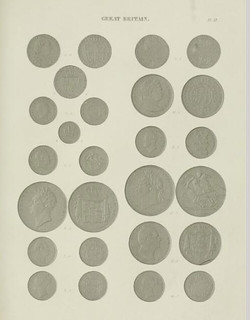
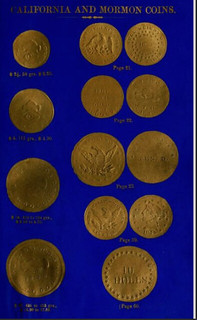
RIGHT: Plate from New Varieties of Gold and Silver Coins, 1850 Edition
Saxton’s machine was steam powered and automatic; an operator did not need to reset it constantly. It was used to prepare engravings for two books, published in 1842 and 1846, by the two assayers at the Philadelphia Mint, Jacob B. Eckfeldt (1803-1872) and William E. Du Bois (1810-1881). These were A Manual of Gold and Silver Coins of All Nations and New Varieties of Gold and Silver Coins, Counterfeit Coins, and Bullion.
Also two other Americans had taken an interest in anaglyptographic engravings, both steel banknote engravers, James W. Steel (1799-1879) and Waterman Lilly Ormsby (1809-1883). Both of these gentlemen had built or acquired medallic engraving machines.
Orsmby was a prominent banknote engraver, foe of forgers, founder of the Continental Bank Note Company, and author of a number of books on these subjects. He maintained that the greatest use of anaglyptographic engravings was – not for book illustrations – but for banknote vignettes. He reproduced anaglyptographic samples, described the process, but we are mostly indebted to him for illustrating his anaglyptograph machine in his 1852 book, A Description of the Present System of Bank Note Engraving.
A few books and journals were illustrated with anaglyptographic engravings in the U.S. after the Civil War, but the far larger use by then was banknote vignettes. Nevertheless, the process rapidly fell into disuse in the 1880s with the rise of photoengraving – making printers’ plates from photographic prints – with a continuous tone (as in colotype or heliotype), or a screened process (as in halftone).
To read the earlier E-Sylum article, see:
VOCABULARY TERM: ANAGLYPTOGRAPHY (http://www.coinbooks.org/v20/esylum_v20n50a15.html) A manual of Gold and silver coins of all
nations
To read the books on the Newman Numismatic Portal, see:
(https://archive.org/details/manualofgold1842jaco)
New Varieties of Gold and Silver coins (1850) (https://nnp.wustl.edu/library/book/512410)
Looking for the meaning of a numismatic word, or the description of a term? Try the Newman Numismatic Portal's Numismatic Dictionary at: https://nnp.wustl.edu/library/dictionary
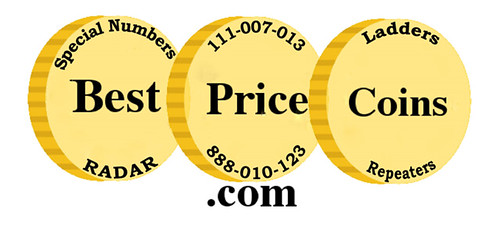
LEISER WOLF SCHNELLING (1897-1981)
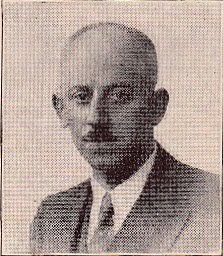 Leiser Wolf Schnelling (1897-1981), was born on September 7, 1897, Berlin, Germany, son of Freide Sißle Schnelling. Leiser is a Jewish Ashkenazic name for Eleazar and is the equivalent of
the Yiddish name, Leyser.
Leiser Wolf Schnelling (1897-1981), was born on September 7, 1897, Berlin, Germany, son of Freide Sißle Schnelling. Leiser is a Jewish Ashkenazic name for Eleazar and is the equivalent of
the Yiddish name, Leyser.
About 1912, as a teenager in high school in Berlin, Germany, a friend of his father gave him a 5 Franc coin with the portrait of Napoleon on it, inspiring him to travel and collect coins.
About 1914 he worked for a bank in Berlin, Germany.
In an interview published in Hobbies, April, 1933 pages 84-85 he is quoted saying :
"Every moment I could spare I spent in the Foreign Exchange Division and had a grand time adding to my collection by making purchases at a small premium. In 1919 realizing the possibilities in the buying and selling of coins I started a coin business and about six years ago came to the United States where I felt there were greater opportunities. I had the usual difficulties experienced by a man who arrives in a strange country unable to speak that country's language, but through perseverance learned how to speak English and accumulated enough money to start a coin company here."
On March 8, 1927, he arrived in New York. He began working and studying English to pass a naturalization exam.
By 1929 or 1930 he began as the proprietor of Colonial Coin Company, 505 Fifth Avenue, New York, New York. Interesting that he had his start on the stock market crash and became a success.
One of Schnelling's more prominent customers was the Prince of Siam. When the King of Siam came to America in 1930 Schnelling was one of the very few who received a personal letter signed by Prince Vipulya, Private Secretary to the King expressing the King's thanks for his best wishes on his successful eye surgery.
His Fixed Price List of 1933 listed coins at prices in three grades. His minor contribution was the cellophane clear view coin boards. In April 1934 he applied for membership in the ANA.
From September 29, 1942 to February 2, 1943 he served in the military as a Warrant Officer, Fort Jay, Governor's Island, New York, during WWII.
On June 15, 1944, he married Lillian Schwartz at Bronx, New York.
He traveled to Cherbourg, France in 1948 returning to New York on April 20th that same year.
He died on August 21, 1981, North Hollywood, Los Angeles, California.
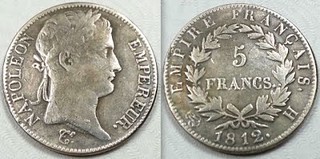
To read the complete article, see:
SCHNELLING, LEISER WOLF
(https://sites.google.com/a/numismaticmall.com/www/numismaticmall-com/schnelling-leiser-wolf)
The entire inventory of the Lupia Numismatic Library is for sale. Individual items will be available before the remaining archives are broken up into parcels sold at philatelic auctions in the U. S. and Hong Kong. Check NumismaticMall.com frequently as dozens of new items with estimates will be posted daily until everything is sold.
All inquiries will be given prompt and courteous attention. Write to: john@numismaticmall.com .
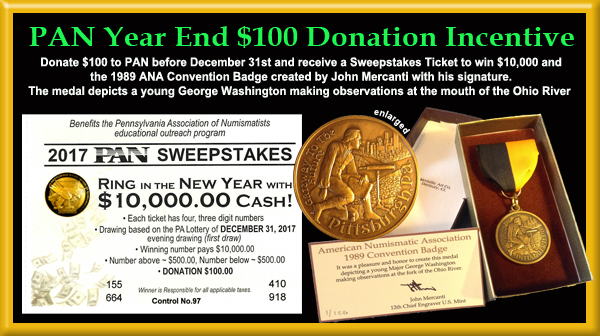
HARVEY STACK'S NUMISMATIC FAMILY, PART 6
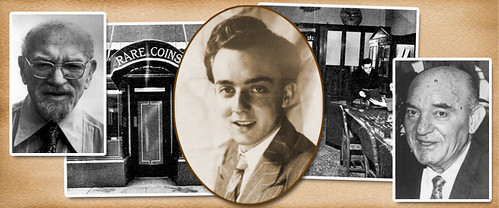
By 1943, the Chase National Bank had decided to disperse another part of the Col. E.H.R. Green collection of gold coins. Col. Green had been such a large buyer of anything he liked, that Chase Bank could not sell all he had at one time or it would overload the market. They might be accused of "dumping" large quantities of coins on the market all at once.
When Chase went to sell items from the Green estate, they offered all his quarter eagles ($2.50 gold -- complete with few duplicates), a massive group of half eagles ($5 gold -- almost two full sets, and virtually hundreds of specimens from the 1795 to 1838 period) and a large group of eagles ($10 gold -- 1795 to 1907, and a full set of the Indian Head design, 1907 to 1933, with many duplicates).
It took a lot of time to get the quantity of these we bought sorted by date and grade and to put them into stock. So even the junior Stack's were engaged to help. Examining all these coins provided a great opportunity to learn about these series, about scarcity, rarity, varieties, and how to judge quality.
Hans M.F. Schulman, who had emigrated from the Netherlands to the United States in the early part of World War II, introduced us to the private secretary to King Farouk of Egypt. He was an avid collector of coins (especially gold), art, postage stamps, unusual jewelry and precious stones. In 1944 the private secretary told Hans that King Farouk wanted to try to get a full collection of United States gold coins. He felt that a collection of gold coins would show his regard for all the United States did for Egypt, protecting it from the German Army during World War II.
The coins from the Green Collection comprised a perfect offering to sell to King Farouk. We put together sets of quarter eagles, half eagles and eagles, made an offer and sold the sets intact to King Farouk. After the king's abdication in 1952 and the sale of his numismatic holdings in 1954 in Cairo, the coins of Col. Green appeared again. In that sale they were sold in large lots, rather than as single coins. A number of dealers from the United States attended the sale. Because of the size of each lot (both in quantity and in value) this sale was a great source for dealer inventory, as many of the lots were too large for most collectors to purchase for themselves. However, two well know collectors, John Jay Pittman and Gaston Di Bello, did attend the sale and acquired a good number of the coins they each needed for their collections.
In 1945 another new collector entered the field, Clifford T. Weihman, who was the largest importer of olive oil in America. He decided to expand his collection of U.S. gold coins, after building a collection of world gold coins. We were able to show him, an incomplete set of United States $5 gold, 1795 to 1929, and a good collection of $10 gold 1795 t0 1933 from the Col. Green Collection. These were the second run Stack's had constructed from their original purchase of gold coins from that source.
After we made these two major sales to Farouk and Weihman, we still had in our inventory a large selection of dates and mints of the $5 and $10 gold, which we offered to collectors at private sale and at public auction.
To read the earlier E-Sylum article, see:
HARVEY STACK'S NUMISMATIC FAMILY, PART 5 (http://www.coinbooks.org/v20/esylum_v20n48a14.html)

POLYMER RING COIN WINS IACA AWARD

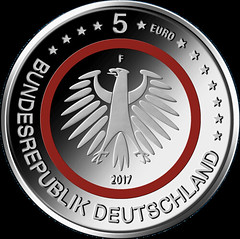
Polymer Coin Wins IACA Award for Best Coin Innovation
The IACA Excellence in Currency 2017 Coin Awards were conferred during The Coin Conference in Warsaw on October 24, 2017. The State Mints of Baden-Wuerttemberg and the Bavarian State Mint were awarded the prize for Best Coin Innovation for their coin featuring a polymer ring.
Every two years, the International Association of Currency Affairs bestows the distinguished IACA Excellence in Currency Awards. On October 24, 2017, a German product was thus recognized: the tri-material 5-euro coin with polymer ring was labelled ‘Best Coin Innovation’.
The idea
Thanks to the polymer ring inserted between the ring and the core, a coin becomes as secure as a banknote for the very first time. The colored polymer ring is not only attractive but also constitutes
an overt security feature that is easily discernible for every user. At the same time, if offers the possibility to equip the coin with covert security features which no counterfeiter is able to copy
at the present state of the art. The new polymer coin would thus make an ideal material for raising the coin-note- boundary. This is an important issue as various countries currently contemplate
raising this boundary.
The IACA Excellence in Currency Award
The International Association of Currency Affairs (IACA) that presents the IACA Excellence in Currency Awards every other year is an organization that unites central banks and ministries of finance,
mints, security printing companies, and many more institutions and companies involved in the cash payment cycle. Composed of experts, an international jury decides every two years which nomination
should be recognized with an award. In contrast to the more widely-known COTY (= Coin of the Year Award), the IACA Excellence in Currency Award exclusively focuses on circulation coins and
concentrates on solutions that are ground-breaking for the entire minting industry.
International recognition for a German idea
This constitutes already the second prize of the professional world with which the polymer coin can adorn itself. In 2016 it won the MDC Award in the category ‘Technologically Most Advanced
Circulating Coin’. The Mint Directors Conference (MDC) is composed of representatives of mints from all around the globe.
The developers
The German State Mints of Baden-Wuerttemberg and the Bavarian State Mints were at the forefront of developing this creation. They were supported by the Leibniz Institute at the Rheinisch-Westfälische
Technische Hochschule (RWTH) in Aachen as well as by representatives of the German Bundesbank. Further major contributors to this development were the vending industry through a representative of
Crane Payment Innovations at Buxtehude and representatives of the blank supplier Saxonia EuroCoin.
To read the earlier E-Sylum article, see:
THE STATE MINTS OF BADEN-WUERTTEMBERG (http://www.coinbooks.org/v20/esylum_v20n49a32.html)
ROYAL MINT MUSEUM ACQUIRES HENRY VII TESTOON
Sale of Coins, Medals and Banknotes
including English Coins from the Archbishop Sharp Collection
Morton & Eden – 7 & 8 December 2017
A two day auction of coins, medal and banknotes held by Morton & Eden in London made a total of £1,570,650 at Morton & Eden in London.
Royal Mint Museum buys rare English shilling of Henry VII for record £52,800
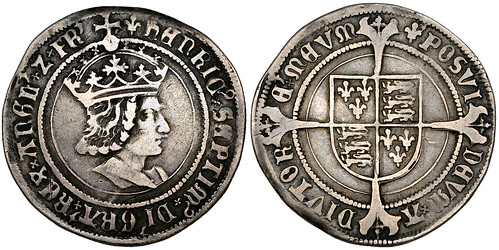
The highlight of the sale was an outstandingly rare testoon (or silver shilling) from the reign of Henry VII, dating from 1502 and bearing a clear portrait of the first Tudor monarch which sold for £52,800 – a record price for an early English testoon at auction. The coin was called a "testoon" because it showed a real likeness of the King's head (from the Latin testa or French tête). It was bought by London coin dealer Christopher Eimer, on behalf of the Royal Mint Museum based in Llantrisant, South Wales.
The coin had previously been in the collection of Dr John Sharp, one of the great British coin collectors of the 17th century. Born in 1644, Sharp became an enthusiastic student of coins and medals. His interest seems to have begun around 1687 when, as Rector of St Giles in the Fields, he ‘found it a good divertisement in the evening’. He later became Archbishop of York from 1691 until his death in 1714. The Archbishop Sharp collection which included some of the rarest and most classic examples of early British coinage made a total of £700,890.
£5 note engraved with micro art work sells for £6,000 on behalf of BBC Children in Need
Also in the same sale was a Bank of England £5 note engraved with a tiny 5mm portrait of novelist Jane Austen and a quote from her famous work Pride and Prejudice by micro-artist Graham Short which sold for £6,000.
The £5 note had been donated to charity, with the wish that it should be used to help young people. The funds raised by the auction will go towards the many worthy causes supported by BBC Children in Need.
The note was bought by an anonymous buyer bidding via the internet.
For mroe information, see:
http://www.mortonandeden.com/
To read earlier E-Sylum articles, see:
BILL ENGRAVED WITH MICRO-PORTRAIT FOUND (http://www.coinbooks.org/v20/esylum_v20n09a30.html)
ARTIST DONATES MICRO-PORTRAIT TO AUSTEN MUSEUM (http://www.coinbooks.org/v20/esylum_v20n17a37.html)

SAN FRANCISCO GOLD COINAGE IN 1857
After reading about the future sale of rare coins and ingots recovered from the S.S. Central America in 2014 by Odyssey Marine, I remembered that years ago I had compiled a chart of the monthly gold coinage figures from the San Francisco Branch Mint for the year in which the S.S. Central America sank, 1857.
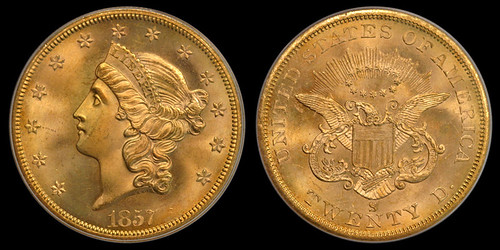
The 1857-S Double Eagle, a date and denomination forever linked to the wreck.
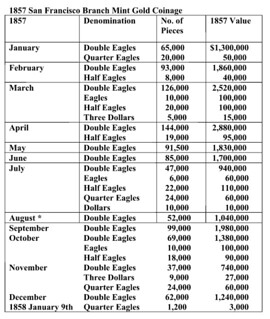
*The S.S. Sonora glided out onto the Pacific Ocean on the morning of August 20th from San Francisco harbor bound for Panama. Her passengers, mail and treasure would then travel by rail across the Isthmus to the Atlantic side where the S.S. Central America was docked in Aspinwall.
One final note that might be of interest to readers of The E-Sylum is the fact that a larger number of 1857-S quarter eagles were recovered from the wreck through the efforts of Odyssey Marine in 2014, versus CADG (the discoverer of the wreck). The final 1,200 1857-S quarter eagles minted, were actually delivered from the Coiner on January 9th of 1858.
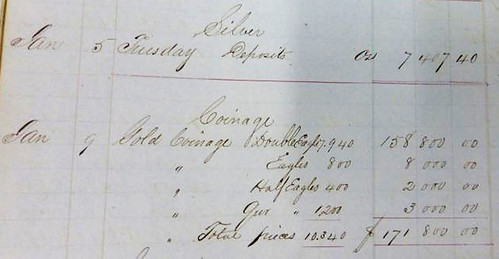

CNG TRITON XXI SALE HIGHLIGHTS
Classical Numismatic Group of Lancaster, Pennsylvania and London, England is proud to present Triton XXI, a Public, Internet, and Mail Bid Sale to be held in conjunction with the 46 th Annual New York International Numismatic Convention (NYINC) on January 9-10, 2018. The 2018 NYINC will be held at a new venue – the Grand Hyatt Hotel, located at 109 East 42 nd Street, New York, NY 10022, between Park and Lexington Avenues.
Triton XXI features 1570 lots of Alexandrian (Roman Egypt), ancient Greek, Celtic, Oriental Greek, Central Asian, Roman Republican & Imperatorial, and Roman Imperial coinage. Additionally, there are featured selections of Byzantine, Early Medieval, Islamic, World, and British Coinage, as well as British Medals and a nice selection of large lots. The pre-sale estimate total for Triton XXI is over $10 million.
Triton XXI is highlighted by a number of collections and individual rarities, which make up the majority of coins on offer:
- The Giovanni Maria Staffieri Collection of the Coins of Roman Alexandria – a magnificent collection assembled over the last fifty years, with 273 lots offered in a separate catalogue
- Greek Coins from the J. L. Gomer Collection
- “Master of the Rhegium Apollo” Tetradrachm from the Eddé and Gillet Collections
- A Beautiful Iconic Athens Didrachm from the Salvesen Collection
- Year 1 Prototype Shekel of the Jewish War
- Extremely Rare Arsinoë III Mnaieion (Oktadrachm)
- Roman Republican and Imperial Coins from the Dr. Allan Smith Collection
- An Exceptional Octavian, Caesar, and Agrippa Denarius
- Roman Aurei from the Jonathan P. Rosen Collection
- A Hoard of Roman Gold and Silver from the Weissenberg Family Collection
- Superb Jahangir Portrait Mohur from the H. W. Collection
- Unique Gold 10 Dukat of Károly (Charles) III of Hungary
- Gold 100 Dukat of Zygmunt (Sigismund) III Wasa of Poland
- The Princeps Collection of Transylvanian Coinage, Part III
- Thrymsas and Sceatts from the Dr. JDR Collection
- An Exceptional Selection of British Gold from the Collections of Jonathan P. Rosen and Arthur M. Fitts III
Lot viewing for Triton XXI will begin on Sunday, January 7 th , from 1PM until 7PM in the Broadway Room, located on the Conference Level (4 th floor) of the Grand Hyatt Hotel.
The complete lot-viewing schedule for Triton XXI is:
Sunday, January 7, 2018 – 1PM until 7PM;
Monday, January 8, 2018 – 9AM until 7PM;
Tuesday, January 9, 2018 – 8AM until 6PM; and
Wednesday, January 10, 2018 – 8AM until Noon.
Auction lots will also be available for viewing at the Pennsylvania offices of CNG from Friday, December 1 st , 2017 until Friday, December 22 th , 2017 by appointment only. Please note that CNG’s office hours will be limited during the holiday season.
The auction sessions for Triton XXI will be held in the Empire State Ballroom I, located on the Ballroom Level (5 th floor) of the Grand Hyatt Hotel. Triton XXI will be conducted over four sessions with the morning sessions beginning promptly at 9:30 AM on Tuesday, January 9 th , and Wednesday, January 10 th , 2018, and the afternoon sessions will start at 2 PM on the same days.
In addition, there will be an online, Internet-only, Session 5 for Triton XXI, which CNG will be conducting as our Electronic Auction 412, and will open for bidding on December 13 th , 2017. E-Sale 412 will feature over 1,000 lots, with a closing date of Wednesday, January 17 th , 2018, and will include coins from some of the same collections listed above.
Printed catalogs for Triton XXI are now available. To order a catalog, please visit www.cngcoins.com. Both catalogs (Staffieri Collection and Triton XXI) are $75 to North American addresses, and $100 to the rest of the world. The individual Staffieri Collection catalog is available for $50 to North American addresses, and $75 to the rest of the world. Payment may be made by U.S. $ check or Visa/MasterCard. Catalogues have already been mailed to customers on CNG’s active mailing list.
About the NYINC:
The New York International Numismatic Convention is the United States’ most prestigious numismatic event targeting the needs of the world and ancient numismatic communities. The 46 th Annual NYINC will be held at the Grand Hyatt Hotel, located at 109 East 42nd Street, New York, NY 10022, between Park and Lexington Avenues. The dates for the 2018 NYINC are Friday, January 5th , 2018 through Sunday January 14 th , 2018, with bourse activities taking place Thursday-Sunday, January 11-14, 2018.
Just a few of the individual highlights from Triton XXI are:
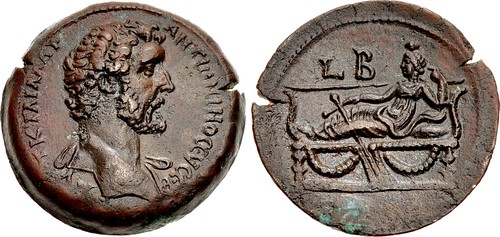
Lot 112–EGYPT, Alexandria. Antoninus Pius. AD 138-161. Æ Drachm (35mm, 25.45 g, 12h). Dated RY 2 (AD 138/139). AV T K T AI? A?P ANT?NINOC ?VC?B, bareheaded bust right, slight drapery / Tyche reclining left on lectisternium (couch), holding rudder with her right hand, resting her left elbow on pile of pillows and propping her head on hand; L B (date) above. Köln 1312-3 var. (obv. bust type); Dattari (Savio) 8765 (this coin, obv. photo is incorrect in the plates); K&G 35.33 var. (same); Emmett 1687.2; Staffieri, Alexandria In Nummis 111 (this coin). EF, attractive reddish brown patina with touches of green. Another early portrait of exquisite execution, which is far superior to any at auction since 2000 for this regnal year. Estimated at $3,000
From the Giovanni Maria Staffieri Collection, purchased from Renzo Canavesi, Sagno, 1996. Ex Renzo Canavesi Collection (Sagno); Dr. Piero Beretta Collection (Milan); Giovanni Dattari Collection, no. 8765.

Lot 152–EGYPT, Alexandria. Antoninus Pius. AD 138-161. Æ Drachm (35mm, 27.94 g, 12h). Labors of Herakles series. Dated RY 4 (AD 140/141). AYT K T AI? A?P • ANT?NINOC • ?YC?B •, laureate head right / Herakles and the Cerynean Hind – Herakles standing right, grasping the antlers of the Cerynean Hind with both hands and leaning on its back with his left knee; behind, Herakles’ club upright; L T? TAPTOV (date) around. Köln –; Dattari (Savio) 8491 (this coin); K&G –; Emmett 1547.4 (R3); Staffieri, Alexandria In Nummis 151 (this coin). Good VF, lovely dark brown patina with smooth surfaces. Very rare. A masterpiece. Only two far inferior examples have been sold at auction since 2000. Estimated at $15,000
From the Giovanni Maria Staffieri Collection, purchased from Dr. Piero Beretta, Milan, October 1976. Ex Dr. Piero Beretta Collection (Milan); Giovanni Dattari Collection, no. 8491.
For his third labor, Herakles was required to capture the Cerynean hind, with its brazen hooves and golden horns, alive and bring it from Oenoe to Mycenae. Herakles chased the stag for one full year before it finally tired, and then he captured it – as shown on the coin type. This type was struck at Alexandria for Pius’ regnal years 4, 5, 6, and 10.
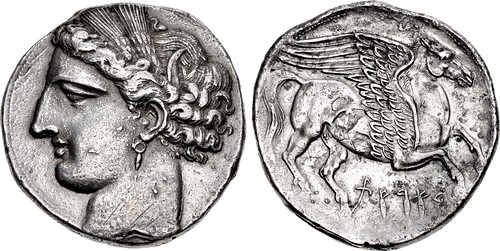
Lot 360–SICILY, Uncertain Punic mint. First Punic War. Circa 264-241 BC. AR 5 Shekels – Dekadrachm (40.5mm, 37.80 g, 1h). Head of Tanit left, wearing wreath of grain ears and single-pendant earring / Pegasos flying right; Punic B'RŠT (= “In the land”) below. Jenkins, Punic, Series 6, 451 (O5/R20 – this coin referenced); Jenkins & Lewis pl. 27, 2; CNP 350; HGC 2, 1664; SNG Stockholm 663 (same dies); Hirsch 1866 (same dies); Kraay & Hirmer 211. Good VF, toned, trace deposits, a couple small scratches and light die rust on obverse, minor metal flaws on reverse. Well struck on a broad flan. Impressive and aesthetically pleasing. Estimated at $30,000
From the Collection of a Northern California Gentleman. Ex Leu 45 (28 May 1988), lot 77; Hess-Leu 45 (12 May 1970), lot 85; Virgil Brand Collection (Hess-Leu 31, 6 December 1966), lot 180.
Although since the late 6th century BC relations between Rome and Carthage had always been maintained on a friendly basis, Rome's growing influence in Magna Graecia in the early decades of the third century BC led inevitably to an increasing rivalry between the two powers. The Italian state was being drawn inexorably into the bitter politics of the centuries-old dispute between Greeks and Carthaginians in Sicily. This magnificent medallic piece was issued at about the time of the outbreak of the First Punic War, which, after almost a quarter of a century of fighting, was to bring about the end of the Carthaginian presence on the island. Find spots for these coins have been exclusively Sicilian, and they were presumably struck for military purposes. Although horses had always been popular on Carthaginian and Siculo-Punic issues, the depiction of the winged Pegasos represented a departure from tradition. The influence of the Corinthian coinage and that of her colony Syracuse seems obvious. The typically enigmatic Punic inscription translates “in the land,” and the Carthaginian stronghold of Panormos on the north coast of western Sicily has been suggested as the mint for this impressive series.
Ex Harald Salvesen Collection
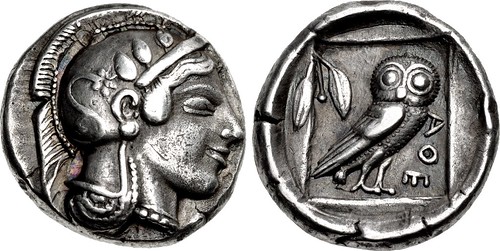
Lot 419–ATTICA, Athens. Circa 475-465 BC. AR Didrachm (19.5mm, 8.42 g, 8h). Head of Athena right, wearing earring, necklace, and crested Attic helmet decorated with three olive leaves over visor and a spiral palmette on the bowl / Owl standing right, head facing; olive sprig to left, ATE to right; all but one leaf of olive sprig within incuse square, the totality within incuse circle. Starr Group IV, 143 (O123/R135); Seltman 473 (same dies); Svoronos, Monnaies, pl. 9, 16 & 19 (same dies); HGC 4, 1617 corr. (Starr groups); SNG Copenhagen 30 (same dies); Boston MFA 1602; Hunterian 10; Rhousopoulos 1979 (same dies); K. Schefold, Meisterwerke Griechische Kunst (Basel, 1960), 458 (this coin). Near EF, beautifully toned. Well centered on a broad flan. Very rare, fewer than 50 didrachms of this type (Starr Groups II–IV) known, of which only about a dozen remain in private hands. Estimated at $50,000
Ex New York Sale IV (17 January 2002), lot 157 (purchased by Harold Salvesen); private collection in Basel (per Schefold [1960]).
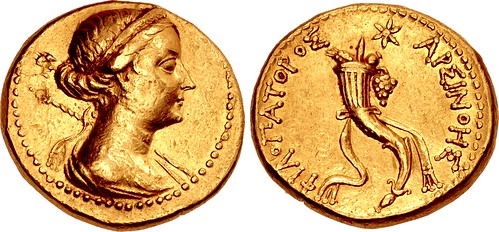
Lot 547–PTOLEMAIC KINGS of EGYPT. Arsinoë III Philopator. Died 204 BC. AV Mnaieion – “Oktadrachm” (27.5mm, 27.71 g, 12h). Uncertain military mint in Phoenicia. Struck under Ptolemy V, circa 202-200 BC. Diademed and draped bust right, wearing stephanos and single-pendant earring; transverse lotus-tipped scepter in background / APSINOHS FI?O?ATOPOS, cornucopia, grape bunch hanging at side, bound with fillet; star above. Svoronos 1269 var. (NI on rev.); Mørkholm, Portrait, obv. die A21; Leu 36, lot 218 (same obv. die); otherwise unpublished. Good VF, a few marks. Extremely rare, one of two known. Estimated at $50,000
Ex Vinchon (13 April 1985), lot 421.
This issue was struck during the Fifth Syrian War (202-195 BC). It is the same obverse die as Svoronos 1269, but lacks the NI control on the reverse, which is also present on certain silver tetradrachms issued at an uncertain Ptolemaic military mint in Phoenicia during this period.
In his study of this coinage, Mørkholm argued that most, if not all, of these portrait issues were struck in Phoenician mints, many of the types being die-linked with mint marked pieces from Sidon, and most of the hoards being found in that region. In addition, the interlinking of dies within each series points to a limited period of minting, perhaps for only a few years after 202 BC, when Ptolemy V was fighting a losing battle to keep his Phoenician territories from falling to Antiochos III of Syria. His portrait types, along with rarer types showing his parents Ptolemy IV and Arsinoë III, lent immediacy to the Ptolemaic presence in Phoenicia.
Important Jewish Reference Aureus
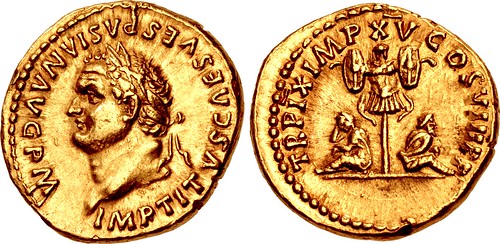
Lot 739–Titus. AD 79-81. AV Aureus (18.5mm, 7.17 g, 7h). “Judaea Capta” commemorative. Rome mint. Struck 1 January-30 June AD 80. IMP TITVS C?ES VESPASI?N ?VG P M, laureate head left / TR P IX IMP XV COS VIII P P, trophy composed of cuirass, helmet, and oblong shields; two captives seated left and right, back to back, in attitude of mourning. RIC II 101; Hendin 1579a (this coin illustrated); Calicó 778 (same dies as illustration); BMCRE –; BN –; Biaggi 379; Kölner Münzkabinett 38, lot 335 (same dies). EF, underlying luster, a few minimal marks. Very rare, especially in this high grade. Estimated at $50,000

Lot 1056–GERMANY, Schaumburg-Pinneberg (Grafschaft). Ernst. 1601-1622. AR Halbtaler (44mm, 14.25 g, 12h). Altona mint; münzmeister Christoph Feistell. Struck 1618-1620. HATS • GODT • VO • RSEHN • SO • WI RTS • GESCHEN • (God hath foreseen, so it will come about), armored figure of Ernst right on horseback, holding scepter; flowers on ground below / DIE ROTE HVR DE • DRACH : REIT • DE KELC : DS GIF : U : GREWELS • TREIT • (The whore [of Babylon] rides the red dragon, carrying the chalice of poison and cruelty), the Whore of Babylon seated right, holding raised chalice, on seven headed beast with one head severed, standing on city gate; to left, grasshopper right; to right, lamb leaping left. Lange 838; Weinmeister 162; KM 105. Good VF, toned. Estimated at $20,000
Ex Friedrich Popken Collection (Künker 244, 6 February 2014), lot 316; UBS 79 (10 September 2008), lot 3072.
The Thirty Years' War was one of the longest and most destructive of European conflicts and involved most of the states of continental Europe. A religious war, it divided the continent between Roman Catholic and Protestant, with both sides viewing the conflict in specifically religious terms. Such views were widely represented on the coinage of the time, thereby conveying the sense of apocalypse felt by the inhabitants. These images became a convenient shorthand for vilifying the opposition and, in this case, the Whore of Babylon was meant to represent the Papacy. The image on this halbtaler derives from Revelation 17:3-4 –
“and I saw a woman sit upon a scarlet colored beast, full of names of blasphemy, having seven heads and ten horns. And the woman was arrayed in purple and scarlet colour, and decked with gold and precious stones and pearls, having a golden cup in her hand full of abominations and filthiness of her fornication.”
The county Schaumberg-Pinneberg had originally been Roman Catholic until the time of Otto IV (circa 1531-1576), who adopted Lutheran teachings, but did not openly confront the Church, since his brothers each were Archbishop-Electors of Cologne. By the time of Ernst, however, Schaumberg-Pinneberg was Lutheran. Because of this, the county did experience some war damage during the Thirty Years’ War. Following Ernst’s death in 1622, he was succeeded by a Roman Catholic relative, Jobst Herman, who ruled without attempting to change the religion of the territories under his rule. His successor, Otto V, (1635-1640) was a Calvinist, though he himself did not try to steer his territories away from Lutheranism, which its inhabitants continue to follow to today.

Lot 1127–POLAND, Monarchy. Zygmunt III Wasa. 1587-1632. AV 100 Dukat (70mm, 349.49 g, 12h). Commemorating the victory over the Turks at Chocim (Khotyn). Bydgoszcz (Bromberg) mint; Jacob Jacobson van Emden, mintmaster, and Samuel Ammon, engraver. Dated 1621 II VA SA. * SIGISMVNDVS · III · D : G : POLONIÆ · ET · SVECIÆ · REX *, armored and draped bust right, wearing ruff and collar of the Order of the Golden Fleece; all within oak wreath border / * MAGNVS · DVX · LITVAN : RVSS : : PRVSS : MAS : SAM : LIVON : ZC’ : *, crowned ornate coat-of- arms within collar of the Order of the Golden Fleece; II and SA within garnish; all within oak wreath border. Czapski 1414; Kopicki 1441; Kurpiewski 1770; Gumowski –; KM H43; Friedberg 72 (this coin cited); Kaleniecki p. 108 (this coin cited). EF, scattered handling marks and hairlines, die break on reverse. One of six total specimens known, and the only example to be offered at auction since 2008. Estimated at $2,000,000
Ex Kroisos Collection (Stack’s, 14 January 2008), lot 3091 (where it appears on the cover); G. Hirsch 53 (26 June 1967), lot 210 (where it appears on the cover).
Like the 1629 Coronation 100 Dukát of Ferdinand III, and the 1677 100 Dukát of Mihály Apafi I, this 100 Dukat of Zygmunt III Wasa is one of the largest European gold pieces ever struck. When this coin sold in 2008, it realized $1,380,000 (including the 15% buyer’s fee); the highest price realized for a gold coin to that date.
Six examples of this issue are known, all from a single pair of dies:
a) Muzeum Narodowe w Krakowe (Emeryk Hutten-Czapski Collection, donated in 1903)
b) Sigismund von Chelminski Collection (Helbing, 25 April 1904), lot 206 (hammer 3000 Gold Marks)
c) F. S. Guggenheimer Collection (Stack's, 22 January 1953), lot 497 (hammer $3000)
d) Stack's (1 February 1957), lot 1031 = Stack's (8 April 1954), lot 1151
e) Stack's (7 December 1989), lot 2207 = Stack's (17 September 1980), lot 2207 = Stack's (7 November 1974), lot 255
f) Kroisos Collection (Stack's, 14 January 2008), lot 3091 = G. Hirsch 53 (26 June 1967), lot 210 (the present example)
The son of Johann III of Sweden and his first wife, Katarzyna Jagiellonka of Poland, Zygmunt III Wasa was elected to the throne of the Polish-Lithuanian Commonwealth in 1587. Still a controversial figure in Poland, his long reign as its king (1587-1632), coincided with the high point of the Polish-Lithuanian Commonwealth. Hoping to create a personal union between the Commonwealth and Sweden, he used his position to take the Swedish throne in 1592, upon the death of his father. Fearing that Zygmunt might use this as an opportunity to re-establish Roman Catholicism in Protestant Sweden, Zygmunt's uncle, Karl (later to become Karl IX), became the leader of the Protestant opposition in Sweden. As king-elect, Zygmunt was forced to confirm the resolutions of the 1593 Uppsala Synod, by recognizing that Sweden was a Lutheran Protestant state. Under this agreement, Karl, along with the Swedish Privy Council, would share power with the king and rule in his place, since Zygmunt remained in Poland. Following Zygmunt's coronation as King of Sweden on 19 February 1594, the new king engaged in a series of reactionary policies designed to curb the power of the Swedish nobility. He ordered that no Parliaments be summoned without his consent. In return, the Swedish Parliament elected Karl as regent. In sympathy with the king, the nobility of Finland (then a part of the Swedish Kingdom), led by Klaus Fleming, rejected this appointment, considering Karl to be a rebel. To counterattack Fleming, Karl instigated a rebellion among the local peasants. Known as the Cudgel War (1596-1597), this rebellion precipitated a larger civil war between Sweden and the Polish-Lithuanian Commonwealth. Through a series of battles in 1598, the Swedish forces under Karl eventually forced the king to accept a peace treaty, under which Zygmunt would be officially deposed and his son, Wladyslaw IV Vasa, would be sent to Sweden as his successor, provided the boy would be brought up as a Protestant. When Zygmunt failed to respond to these demands, the Swedish Parliament elected Karl as the new king.
As King of Poland, Zygmunt's primary goals were to create a strong and stable Polish government, as well as combating heresy in all its forms. While such policies were unsuccessful in Sweden, he was more successful against the Ottomans. Viewed as a Christian bulwark against the Turks, Zygmunt was eager to assist Austria. Promised territorial gains for the kingdom in return for his assistance, Zygmunt sent mercenaries to the Principality of Moldavia to extricate the Ottomans from the area. At the Battle of Chocim (modern Khotyn) in 1621, the Polish-Lithuanian Commonwealth held the forces of Sultan Osman II and his Janissaries at bay until the first autumn snows. Aided by the Polish hussars, a heavy cavalry known as winged, because their armor included a pair of wings on their back, the Ottomans, sustaining heavy losses, were forced to abandon the field. Although indecisive in its outcome, the battle – the largest in the history of the Commonwealth to date – was proclaimed a great victory over the “heathens”, and became subsequently an event of great cultural pride in succeeding years (see, for example, Waclaw Potocki's, Transakcja wojny chocimskiej [The Progress of the War of Chocim], written between 1669 and 1672). Struck by Jacob Jacobson van Emden, with dies engraved by Samuel Ammon, this impressive gold 100 Dukat was struck to commemorate this victory.

Lot 1188–TRANSYLVANIA, Principality. Gábor Bethlen. 1613-1629. AR Taler (42mm, 10h). Körmöcbánya (Kremnitz / Kremnica) mint. Dated 1621 KB. * GABRIEL D ? G ? EL ? HVNGARIÆ ? DAL ? CR SCL ? REX, armored half-length bust right, holding scepter over right shoulder; coat-of- arms and Madonna with child in legend / ? TRANS ? PRINCEPS ? ET ? SICVLOR ? COM ? 1621 ?, crowned coat-of- arms; K B flanking. Resch 91; MBR 1308; KM 134; Davenport 4710. In NGC encapsulation graded XF Details, edge filed, cleaned. Toned. Estimated at $2,000
From the Princeps Collection.
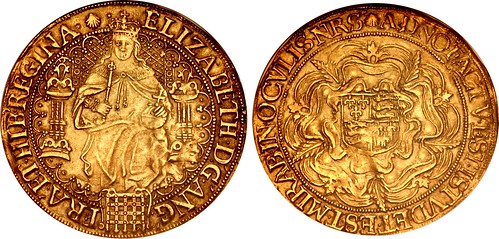
Lot 1438–TUDOR. Elizabeth I. 1558-1603. AV Sovereign (43mm, 1h). Sixth issue. Tower (London) mint; im: escallop. Struck 1584-1586. ELIZABETH · D’ · G’ · ANG’ · FRA’ · ET : HIB’ · REGINA · (escallop), Elizabeth, holding lis-tipped scepter in left hand, right hand set on globus cruciger propped on her knee, seated facing on ornate throne with pellets on back and pillars with annulets and double pellets; all within tressure of arches; portcullis (with chains) below / (escallop) A · DNO’ · FACTV’ · EST · ISTVD · ET · ES·T · MIRAB · IN · OCVLIS · NRS’, royal shield in center of Tudor rose. Brown & Comber A11 (but no indication of scallop over A on rev.); Schneider –; North 2003; SCBC 2529. In NGC encapsulation, graded AU 55. Estimated at $20,000
From the Jonathan P. Rosen Collection.
For further details and any additional information, please contact CNG, Inc. at:
Classical Numismatic Group, Inc.
P.O. Box 479
Lancaster, PA 17608-0479
Telephone: (717) 390-9194
Fax: (717) 390-9978
Email: cng@cngcoins.com
THE BOOK BAZARRE
OVER 500 NUMISMATIC TITLES: Wizard Coin Supply has over 500 numismatic titles in stock, competitively discounted, and available for immediate shipment. See our selection at www.WizardCoinSupply.com.STACK’S BOWERS OFFERS COLOMBIAN COINS AND PAPER
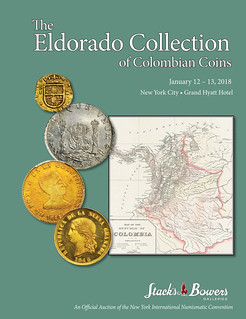

The Eldorado Collection of Colombian Coins and Paper Money
The Eldorado Collection of Colombian Coins and Paper Money, to be offered in two auction catalogs, is the finest ever cataloged and represents an important event in Latin American numismatics. The Eldorado Collection is so sweeping in scope, that these catalogs are only the initial offerings, featuring many of the rarest and highest grade selections from this epic cabinet. Stack’s Bowers Galleries is pleased to be showcasing the first installment of this collection as part of their official auction January 11-13, 2018, during the New York International Convention at the Grand Hyatt Hotel in New York City. The January offering of the Eldorado Collection shepherds together many of the most notable highlights from this wide-ranging cabinet, an accomplishment that was many decades in the making.
The coins span chronologically from the very first gold coin of the New World -- the 1622 2 Escudos struck in Cartagena, a historic masterpiece of global importance -- to modern issues of the Bogotá Mint. In the 350 years of history these coins bookend, a nation blossomed, from colony, through fits and starts of several republican (and not so republican) governments, to a modern power. The earliest coins represent some of the first treasure taken from the ground by representatives of the Spanish crown, while those of the 19th century show a nation whose wealth made it a player in world trade, and a home to growing cities and grand aspirations.
This remarkable historical legacy is written in gold and, to a lesser but still important extent, silver. The vast majority of the coins in this offering are gold: onzas from colonial days and their later descendants, patterns of European workmanship and great beauty, and smaller denominations intended not for world trade, but local circulation. The silver coins here are all from Colombia's colonial beginnings: a world class collection of cobs, from Cuartillos to 8 Reales; rare Pillar types; and an extensive run of portrait coins depicting Carlos III and Carlos IV, including many struck during the reign of Ferdinand VII.
The paper money, featured in its own sale catalog, portrays the broadest view of this subject ever published in English or Spanish. Commencing in 1819 and continuing to the present day are countless note types, from the majority of known series and issuers, cataloged and offered in this and subsequent sales for the first time. The lot descriptions and their accompanying full-color images often confirm rumored examples listed, but unpriced, in the Standard Catalog of World Paper Money.
Many are first time individual offerings at public auction. This is especially true of previously unlisted types that were discovered in the Archives of the American Bank Note Company, sold by Christie’s initially on November 28- 29, 1990. Nearly all 66 Colombia lots enumerated in that “Leo” moniker catalog (including two immense and unique record books) were obtained at the sale by Eldorado’s architect, who recognized their immense research importance and the opportunity to expand the collection’s scope in the span of a few hours.
For more information, see:
http://www.stacksbowers.com/
Lot 11001: COLOMBIA. 1753-S 4 Escudos

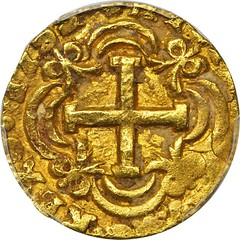
COLOMBIA. 1753-S 4 Escudos. Santa Fe de Nuevo Reino (Bogotá) mint. Ferdinand VI (1746-1759). Restrepo M96.9. AU-55 (PCGS).
To read the complete lot description, see:
COLOMBIA. 1753-S 4 Escudos. Santa Fe de Nuevo Reino (Bogotá) mint. Ferdinand VI (1746-1759). Restrepo M96.9.
(https://auctions.stacksbowers.com/lots/view/3-967HH)
Lot 11367: 1842 Ecuador 8 Escudos

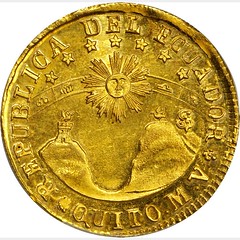
Finest Known 1842-MVS Ecuador 8 Escudos
To read the complete lot description, see:
ECUADOR. 1842-MVS 8 Escudos. Quito mint. KM-23.2. (https://auctions.stacksbowers.com/lots/view/3-966AY)
Lot 10008: 1863 Estados Unidos de Colombia 2 Pesos
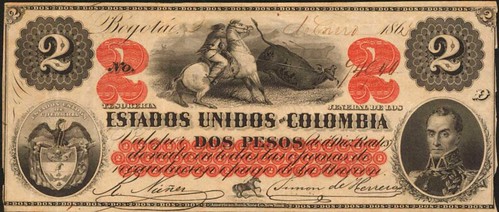
A superb grade example from a beautifully engraved ABNCo. series. This is fully issued with written serial number. There are a complete interest payment stamp on the back, an added endorsement, and it is endorsed in the center. The style is like an American obsolete note from the period. The roping scene at the top was originally engraved by Danforth, Wright & Co. Vermillion guilloche and "2" counters along the bottom. Engraved signatures. One of the best observed and graded. This will certainly garner much attention from all world note collectors who appreciate rarity and style.
To read the complete lot description, see:
COLOMBIA. Estados Unidos de Colombia. 2 Pesos. 1863. P-75. (https://auctions.stacksbowers.com/lots/view/3-95XE1)
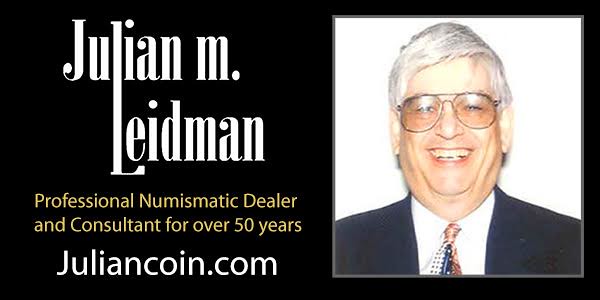
ARCHIVES INTERNATIONAL SALE #46 SELECTIONS
Lot 270: Sheet of 1st Issue 50c Postal Currency

50 cents, Issued, Green, Each note has a Strip of 5 overlapping 10 cent Washington stamps in middle, ABNC monogram on back of each note, Uncut sheet of 16 notes, folded vertically between the notes and lightly horizontally between the middle group of notes
To read the complete lot description, see:
U.S. Fractional Currency, 1st Issue 50 cents Fr#1312, Uncut
Sheet of 16 Notes. (http://auction.archivesinternational.com/U-S-Fractional-Currency-1st-Issue-50-cents-Fr-1312-Uncut-Sheet-of-16-Notes_i28630727)
Lot 272: Fractional Currency Shield

Washington, D.C., Fractional Currency Shields were designed to be used in banks and post offices for counterfeit detection. Printed between June 1866 and May 1869, they were composed of 39 First, Second, and Third issue notes. There are 20 faces and 19 backs, all uniface specimens. All of the notes are clean and bright except for the 25¢ 2nd Issue back which has faded to light blue as usual. There are 4 hand signed notes with 3 being Jeffries-Spinner and the 10¢ 3rd Issue, being a Colby-Spinner. The gray background is bright and sharply printed with the stars and eagle with minimal water staining only on the bottom edge, though there are some light foxing areas, still a superior example of this popular fractional shield. The frame that is oft-times referred to as original is contemporary since the shields were all shipped flat and unframed. An exceptional example rarely seen offered this nice.
To read the complete lot description, see:
U.S. Fractional Currency Shield, Fr. 1382 With Gray Background,
ca.1866-1869. (http://auction.archivesinternational.com/U-S-Fractional-Currency-Shield-Fr-1382-With-Gray-Background-ca-1866-1869_i28630729)
Lot 49: Yue Soo Imperial Bank, 1908 Silver Dollar Issue

Soochow, Kiangsu Province, China. 1908, 1 Silver Dollar Local Currency, P-S1232b, S/M#C122-10, Issued banknote, Lower left corner clipped, Brown with green underprint, back with facing dragons, S/N: Y No.56568, Fine to Choice Fine condition with no edge faults, Rare note in any form. IPCL. (Pogrebetsky Family Archives, Part 2)
To read the complete lot description, see:
Yue Soo Imperil Bank, 1908 Silver Dollar Issue.
(http://auction.archivesinternational.com/Yue-Soo-Imperil-Bank-1908-Silver-Dollar-Issue_i28630506)
Lot 217: 1776 United States Lottery Ticket

Philadelphia, Pennsylvania lottery ticket issued according to a Resolution of Congress in 1776, Lottery #14m, Lottery ticket # 570, Indented left margin with ornate design, signed by Ja Buddin. AU with light toning, exceptional condition for one of the first U.S. Government related lotteries.
To read the complete lot description, see:
United States Lottery, Class the Third, November 18, 1776
Issued Lottery Ticket. (http://auction.archivesinternational.com/United-States-Lottery-Class-the-Third-November-18-1776-Issued-Lottery-Ticket_i28630674)
For more information on the sale, see:
https://archivesinternational.com/
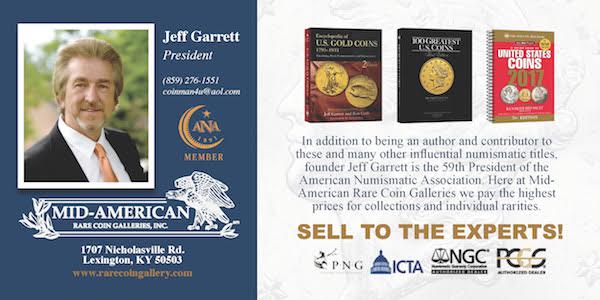
HEEGEMAN COLLECTION OF NEW ZEALAND TOKENS
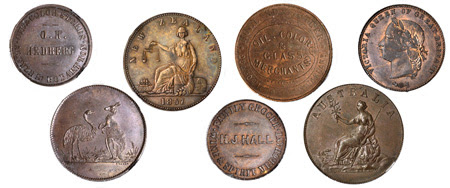
Stack's Bowers Galleries is pleased to offer the collection of popular tradesmen tokens of New Zealand as assembled by Mr. James Heegeman. Mr. Heegeman had spent nearly 40 years collecting, and acquired the nicest examples he could find. His collection includes many rare to extremely rare varieties, mules and patterns, an accumulation that clearly took him decades to assemble and painstakingly attribute.
Among the highlights of the collection is a Pattern Penny Token, 1879, by J. Moore of Birmingham (unsigned) It is attributed as Andrews-399; Lampard-336; Renniks-392; KM-unlisted; Forrer-pg.136/141 and is rated Rarity 7. It was engraved by the talented Mr. Joseph Moore whose works were so well done that they even impressed the famous Mr. William Wyon, chief engraver at the Royal Mint.
Several high grade and extremely rare mules from different locations are found in the Heegeman Collection and include:
- A Christchurch/Sydney, New South Wales, Brisbane, Queensland. Henry J. Hall/Flavelle Bros & Co. Penny Token Mule, ND (ca. 1857). Andrews-160; Lampard-322d; KM-TN30; Gray-90a; Renniks-174. Rarity 9-10. This piece displays lovely smooth chocolate patina.
- A Wellington/Australia (Hobart, Tasmania). Lipman Levy/O.H. Hedberg. Penny Token Mule, ND. Andrews-324; Lampard-328c; KM-TN41(Obverse), 96.1 (Reverse under Australia); Gray-162c; Renniks-325. Rarity 8-9. It is well struck with lovely smooth surfaces displaying a mixture of chocolate, mahogany and rose hues. A later striking made for collectors.
- A Christchurch/Launceston, Tasmania. Henry J. Hall/E.F. Dease. 1/2 Penny Token Mule, ND(ca. 1865). Andrews-163; Lampard-322b; KM-TN26; Gray-91b; Renniks-110. Rarity 8-9. Sharply struck with lovely chocolate and mocha patina throughout.
- A Wellington/Hobart, Tasmania. Lipman Levy/O.H. Hedberg. 1/2 Penny Token Mule, ND(ca. 1857). Andrews-325; Lampard-328f; KM-TN89; Gray-102h; Renniks-211. Rarity 9. Sharply struck with lovely smooth chocolate patina.
To view The James Heegeman Collection of New Zealand Tradesmen Tokens, see:
https://auctions.stacksbowers.com/auctions/3-96PNG?view=list&sort=lot_number&is_mixed_lot=sometimes&limit=36&jump_to_lot=24519
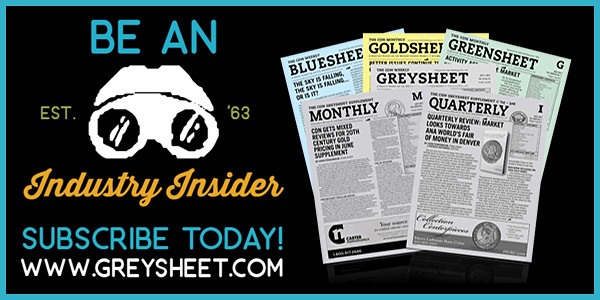
CHRISTMAS TOKENS
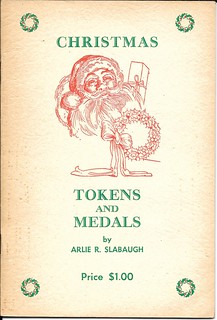 In the last issue of The E-Sylum you asked for Christmas items including tokens. I have attached images of four pieces from my collection.
In the last issue of The E-Sylum you asked for Christmas items including tokens. I have attached images of four pieces from my collection.
I also scanned the booklet cover of a booklet on Christmas tokens. It is titled Christmas Tokens and Medals by Arlie R. Slabaugh printed in 1966. He listed 69 pieces from the U.S. and five pieces from Canada and foreign countries. The last page of his booklet he included a Christmas poem he wrote.
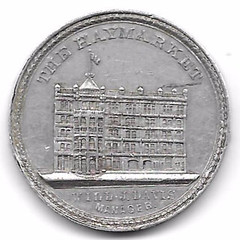

Token #1 - Listed by Slabaugh #5 Aluminum, 37mm, Chicago, IL. Also listed by Rulau #Chi 82. Below Rulau's token description of this piece it said: This commemorative at Christmas, 1890 marked the theater's third anniversary. It opened at Christmas, 1887. It is said that Davis hid Negro slaves in the top floor of this same building during the Civil War.

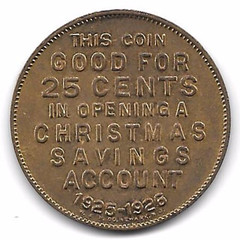
Token #2 Listed by Slabaugh #16. Brass, 32mm. It is from Flushing, New York.
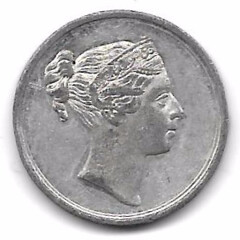
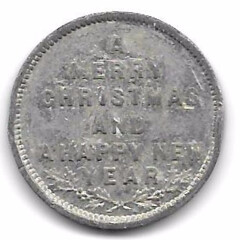
Token #3 Unlisted by Slabaugh. White metal, 23mm, location and issuer unknown.
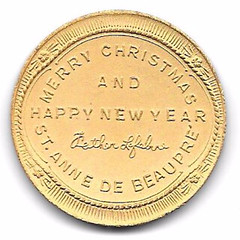
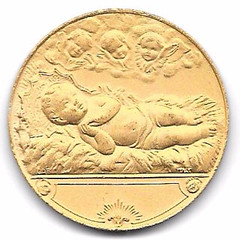
Token #4 Unlisted by Slabaugh. Gold aluminum, 32mm, from Quebec, Canada.
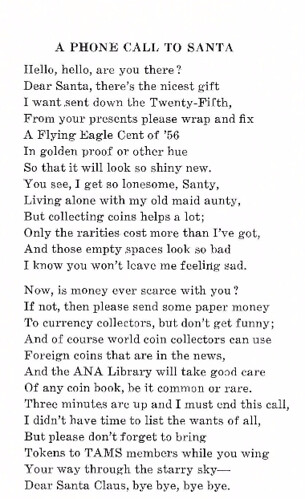
Merry Christmas and Happy New Year,
Tom Casper
To read the earlier E-Sylum article, see:
HAVE A NUMISMATIC CHRISTMAS (http://www.coinbooks.org/v20/esylum_v20n50a30.html)
CHRISTMAS TURKEY COINS
Christmas Turkeys or bad things good people do to collectable coins.
Piercing
I do not understand what comes over people who, no doubt at other times are perfectly sensible sane level headed etc. What enters their head and makes them drill a hole through a coin? If they want
jewellery go to jeweller. Presumably they do not think about drilling a hole through a watch and hang it round their necks. What is even worse is when the piercing breaks leaving a gap. Piercings are
fashion accessories and are not for coins.
Plugs
A few rare coins have plugs as part of the design which is just about acceptable. But why fill a hole. It never looks good. It is obvious that it has been done.
Mounting
“Traces of being mounted” is a phrase seen frequently. Someone has tried to convert a golden guinea or angel into a broach and changed their mind and tried to remove the evidence. Coins are coins not
broaches.
Bending
I am not sure how they do it. Did they try to feed a coin into a slot machine or remove one that is stuck? Or perhaps they wanted to see what happened if they let a train run over a coin. There are
coins that have been deliberately bent to be used as votive objects but this is not an idea to be tried at home.
Cutting
I suppose in Middle Ages if you wanted to buy a loaf that cost a farthing you handed over a penny. The shopkeeper might then cut the penny into four pieces and give you three in change. Obviously the
idea did not catch on because halfpennies and farthings were invented. I have heard of bank notes being cut in half. When a house was being purchased one clerk would be given half the banknotes and
the other would have the rest. They went by different routes and that way there was no risk in one clerk being robbed or dishonest. (However clearly if they got together there could be a problem). Do
not try this at home!
Colouring
Sorry, coins are meant to be coloured the colour of the metal. Yes I know it is skilled job to enamel a coin, but really?
Graffiti
Collecting really took off in the Eighteenth Century. Educated people went on the Grand Tour and got interested in the classics. Many started collecting Greek and Roman coins which they called “large
brass medallions” just to confuse later generations as they were not made of brass or medallions. The proud owners sometimes wrote on the coin their name and a few details. Well why not? It saved
buying coin tickets that could get lost. No! Do not write or scratch your name on a coin.
Wrong material
People have experimented with all sorts of materials including plastic, porcelain or even cardboard. Coins should be made of metal.
Junk boxes
I love junk boxes/rummage tins but object to dealers that either do not price them or overprice. You find something rare at bottom of box and the dealer says that will be £10.00. No! You are doing
the work for him by finding the elusive rare item. I have seen junk boxes marked at £40 each. This is not a junk box
A real turkey
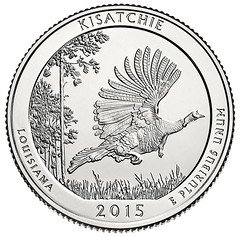 I will end this list of dislikes with a very positive and definite like. This is the only coin I know of with a turkey bird on it. It is an excellent design as it is not easy to make a
flying turkey look good. It is the 2015 Kisatchie National Forest quarter featuring the National Forest of Louisiana and is the second national site to be honoured from the United State Mint’s
program of America the Beautiful quarters.
I will end this list of dislikes with a very positive and definite like. This is the only coin I know of with a turkey bird on it. It is an excellent design as it is not easy to make a
flying turkey look good. It is the 2015 Kisatchie National Forest quarter featuring the National Forest of Louisiana and is the second national site to be honoured from the United State Mint’s
program of America the Beautiful quarters.
The coin was designed by Susan Gamble and sculpted by Joseph Menna, it depicts a wild turkey in flight over blue stem grass, and a long leaf pine tree in the background. Sadly, the designer Susan Gamble died at a young age in 2015. Gamble also won the international Coin of the Year Award for Historical Significance for the United States of America for her 2007 Jamestown silver dollar design.
THE BOOK BAZARRE
NOW in its SECOND EDITION! Q. David Bowers’s popular Guide Book of Washington Quarters analyzes each coin, year by year, from 1932 to 1998, and focuses a comprehensive section on each quarter from 1999 to date. The new second edition is expanded to 352 pages. Order your copy for $19.95, online at Whitman.com , or call 1-800-546-2995.THE HONG KONG PLAGUE MEDAL
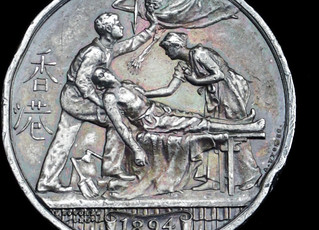 A rare Hong Kong Plague medal awarded to a 19th century Shropshire soldier is set to fetch nearly £1,000 at an auction next week.
A rare Hong Kong Plague medal awarded to a 19th century Shropshire soldier is set to fetch nearly £1,000 at an auction next week.
The medal was presented to former labourer, Private Richard Corfield, for the relief work he carried out during the bubonic plague epidemic which broke out in Hong Kong in May 1894.
Private Corfield was 26 and serving with the 1st Battalion of the Shropshire Light Infantry in Hong Kong at the time of the epidemic.
He was one of hundreds of Midlands soldiers who went to the aid of stricken residents.
“Approximately 600 men of 1 KSLI served at various times.
"The work was unpleasant in the extreme, searching narrow backstreets and overcrowded houses for plague victims, tending the sick in makeshift hospitals and disinfecting the houses and streets with chloride of lime and whitewash.
“That is why Shrewsbury-born Private Corfield and his colleagues became known as ‘The Whitewash Brigade’.”
The soldiers lived in quarantine in separate tented camps and were given extra rum rations to help them cope with the gruelling work.
Fortunately Private Corfield survived and was eventually discharged from the army in 1907, when he was 39.
Now, more than 100 years later his 1894 Hong Kong Plague medal is coming up for sale.
It is expected to fetch between £700 and £900 at Spink in London on Tuesday.
Marcus Budgen, a medals specialist at Spink, said the item is an undoubted rarity.
He said: “Only about 800 plague medals were issued for 1894,with approximately 500 being issued to the Shropshire Light Infantry, so Private Corfield’s medal is a rarity without any doubt.”
The Shropshire Regimental Museum owns 30 of the 1894 Hong Kong Plague medals.
To read the complete article, see:
Rare plague medal earned by
Shropshire soldier to go under the hammer
(https://www.shropshirestar.com/entertainment/shrewsbury-entertainment/2017/12/01/rare-plague-medal-earned-by-shropshire-soldier-to-go-under-the-hammer/)

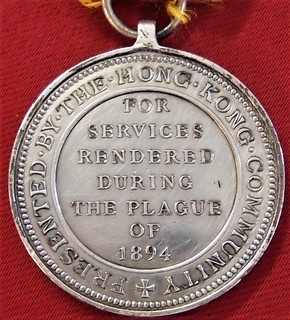
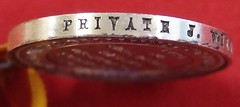

To read the complete article, see:
RARE 1894 HONG KONG PLAGUE MEDAL SILVER WILLIAMS SHROPSHIRE
LIGHT INFANTRY CHINA (https://www.jbmilitaryantiques.com.au/product/rare-1894-hong-kong-plague-medal-silver-williams-shropshire-light-infantry-china/)
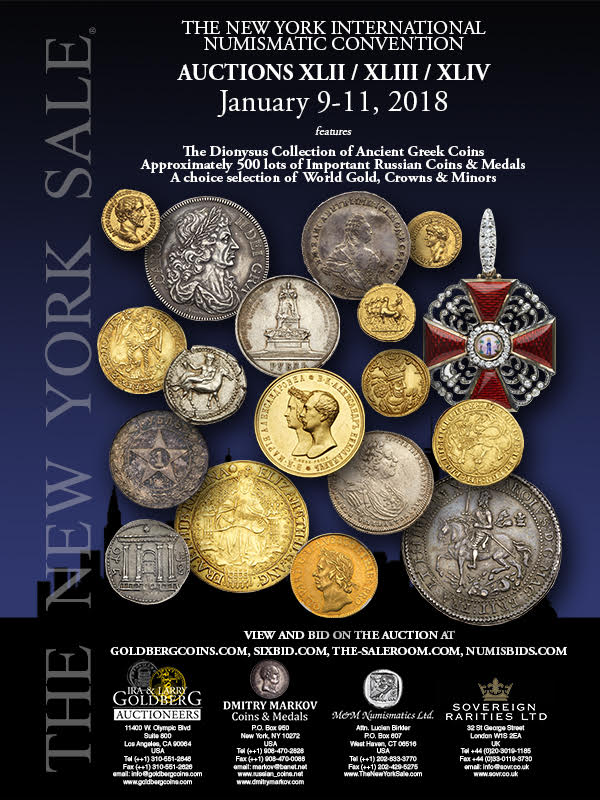
CARRIER PIGEON'S DICKIN MEDAL UP FOR SALE
The Victoria Cross is the highest British military honour, but in the animal kingdom the equivalent is the Dickin Medal. The award earned by a pigeon called Princess is coming up at auction at Holloway’s of Banbury on December 12.
Dickin Medals – the ‘animals’ VC’ - were established in 1943 by the People’s Dispensary for Sick Animals (PDSA) to recognise acts of bravery by birds and animals during wartime. They were named after Maria Dickin, PDSA founder.
On November 17, a dog called Mali became the 69th recipient of the honour. Mali was seriously injured when helping British and Afghan Special Forces to clear a building in the capital Kabul in 2012 following a Taliban attack.
Another 31 dogs have received a Dickin Medal, along with four horses, a cat and 32 Second World War messenger pigeons.
Carrier pigeons were often used as military messengers in both world wars because of their homing ability, speed and altitude.
Princess, a smokey blue carrier pigeon hen, was one of them. The medal was given posthumously for carrying an important message from Crete to Alexandria while serving with the RAF in 1943.
The flight of 'Princess 42 W.D.593' is listed by the PDSA as one of the finest performances of pigeons in war service: a staggering 500 miles mostly over water. Princess died before she could be awarded the medal so it was presented to a fellow RAF pigeon at a ceremony in May 1946.
The medal is accompanied by its certificate and explanatory letter and two press photographs of the award ceremony, with the lot overall estimated at £7000-10,000. This lot comes directly from the family of the trainer.
Medals awarded to famous animals tend to make higher prices. In April 2009 London auction house Spink sold the Dickin Medal awarded to Rip, a stray dog who had been found starving in Poplar, east London, after a heavy air raid in 1940, for £21,000. Adopted by the local ARP Warden, he acted as an unofficial rescue dog, sniffing out casualties trapped under buildings, and during the course of the war he located more than 100 air raid victims.
The Dickin Medal won by Commando, a Second World War carrier pigeon, made £8000 against an estimate of £5000-7000 at Spink in November 2004.
To read the complete article, see:
The Animal VC awarded to plucky messenger pigeon
Princess comes up at auction in Banbury (https://www.antiquestradegazette.com/news/2017/the-animal-vc-awarded-to-plucky-messenger-pigeon-princess-comes-up-at-auction-in-banbury/)
CRANE COMPANY BUYS CRANE CURRENCY
Crane Co., a diversified manufacturer of industrial products, including vending machines and payment systems, said it will purchase Crane Currency from private-equity firm Lindsay Goldberg, members of the Crane family and other shareholders, for $800 million on a cash- free and debt-free basis.
Founded in 1801, Crane Currency is a pioneer in advanced micro-optic security technology, and a fully integrated supplier of secure, highly-engineered banknotes for central banks all over the world.
Stamford, CT-based Crane Co.'s Crane Merchandising Systems unit is the nation's largest manufacturer of vending machines, vending software systems and cashless payments technology. Its Crane Payment Innovations is a leading producer of cash and cashless payment systems.
"We are extremely excited to announce this transaction, which will be Crane Co.'s second largest ever, and brings together two companies with nearly 380 years of combined history. Crane Currency is the fastest-growing fully integrated global currency provider in the growing global banknote supply and security industry," said Crane Co. chief executive Max Mitchell. "Making it part of Crane Co. is a logical extension of our expanding presence in the currency and payment markets. Our combined businesses will be able to offer end-to-end currency and security solutions, from substrate manufacturing and banknote design and printing to micro-optics and banknote validation."
Crane Currency is expected to have 2017 sales of approximately $500 million. Crane Co. intends to finance the acquisition through a combination of cash on hand and additional debt. The transaction is expected to take place early in the first quarter of 2018.
Chicago-based Crane Co. was founded in 1855 and is a diversified manufacturer of industrial products including chemical and power systems, payment systems and vending machines. -Editor
To read the complete article, see:
Crane Co. To Acquire Banknote Manufacturer Crane Currency For $800 Million
(https://www.vendingtimes.com/articles/crane-co-to-acquire-banknote-manufacturer-crane-cu-11256)
To read the complete press release, see:
Diversified Industrial Crane Co. to Acquire Boston-Based
Crane & Co., Inc. ("Crane Currency") for $800 Million
(http://files.shareholder.com/downloads/CR/5682797683x0x965930/1ccba512-8a34-4ced-ac90-c23bf6a1c612/CR_News_2017_12_5_General.pdf)
To visit the company web sites, see:
https://www.cranecurrency.com/
http://www.craneco.com

KAZAKHSTAN NOTE DESIGNERS ACCUSED OF PLAGIARISM
 Marcel Burkhard, a Swiss photographer, is arguing that a seagull that appears on the latest version of a 500 tenge ($1.50) Kazakh banknote is a carbon copy of one he photographed over a
decade ago. That photograph appears on the Russian-language Wikipedia article for “gulls” and is labelled as “an ordinary gull”.
Marcel Burkhard, a Swiss photographer, is arguing that a seagull that appears on the latest version of a 500 tenge ($1.50) Kazakh banknote is a carbon copy of one he photographed over a
decade ago. That photograph appears on the Russian-language Wikipedia article for “gulls” and is labelled as “an ordinary gull”.
Officials in the land-locked Central Asian country where Russian is widely spoken have failed to acknowledge copyright infringement despite a social media-driven outcry. But tellingly they have belatedly suggested that “with time” the design of the banknote will be changed.
On December 4, according to Kazakh media, Burkhard wrote on Facebook:
On Friday I received a message from a Kazakh social media user, [who said] that on a new Kazakhstan banknote there is a seagull similar to my photograph. I examined the banknote and, truly, it seems to be one and the same gull. To compare, I cut out the seagull from my photograph and inserted it onto [a copy of] a banknote. Every detail matches and for that reason I am confident that the image is one and the same.
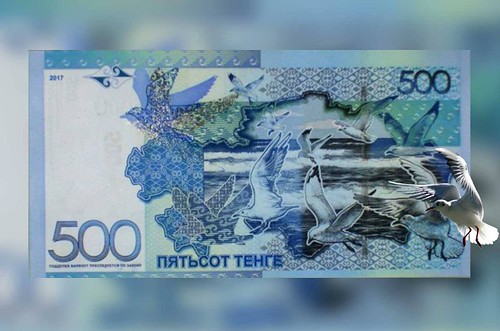
Kazakh banknote with Marcel Burkhard's Seagull Superimposed
By December 5, with accusations of plagiarism still doing the rounds on social media, the bank said the design of the banknote would change “with time” and that symbols for the banknote would be exclusively hand-drawn to prevent possible falsification.
There was no immediate confirmation that the seagull would be removed from the note, however.
Although it was largely the troublesome bird that caught the eye of Kazakh social media users, many were even more bemused to find out that a business centre called Moskva (Moscow) in Kazakhstan's capital Astana had found its way onto the same 500 tenge banknote.
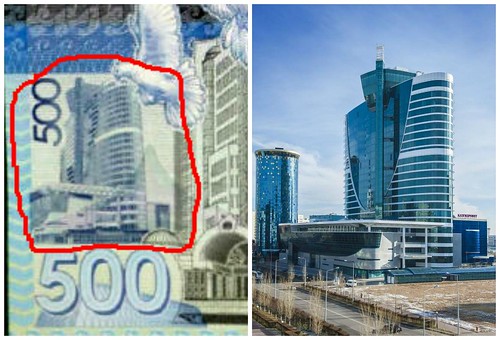
To read the complete article, see:
What Future for the ‘Wikipedia Seagull’ on Kazakhstan's Brand New
Banknotes? (https://globalvoices.org/2017/12/08/what-future-for-the-wikipedia-seagull-on-kazakhstans-brand-new-banknotes/#)
RABBI TELLS FOLLOWERS NOT TO LOOK AT BANKNOTE
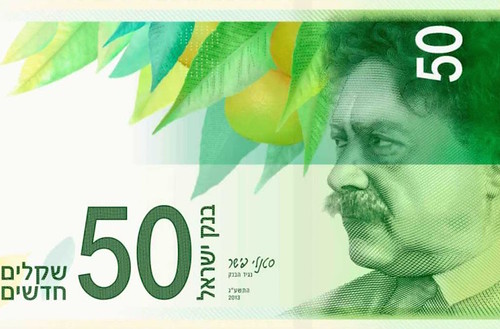
A prominent haredi Orthodox Sephardi rabbi in Israel ruled that religious people should not look at the 50-shekel banknote because the poet featured on its front was married to a Christian woman.
Rabbi Benzion Mutzafi reportedly made the ruling over the weekend concerning the bill showing Shaul Tchernichovsky, a renowned Hebrew poet who was married to a non-Jewish Russian woman named Melania Karlova. The ruling was first reported on the haredi Orthodox news website Kikar Hashabbat.
The bill was unveiled in 2014.
“They say that at the time, (then-chief rabbi) Rabbi Avraham Kook begged, implored and asked him to try to convince her to convert to Judaism. And he refused,” Mutzafi reportedly said of Tchernichovsky.
The rabbi also said: “In our tradition, there are grave things written about whoever (lives) with a Christian. Tied to him like a dog. (They) are called apostates.”
Mutzafi reportedly took out a 50-shekel banknote and told one of his students that he was forbidden from looking at it. The rabbi said he keeps such banknotes folded with the portrait on the inside so he does not have to look at it.
To read the complete article, see:
That 50-shekel bill with the
intermarried poet’s picture? Don’t look at it, an Israeli rabbi rules.
(https://www.jta.org/2017/12/04/news-opinion/israel-middle-east/that-50-shekel-bill-with-the-intermarried-poets-picture-dont-look-at-it-an-israeli-rabbi-rules)
FEATURED WEB SITE: MEDALLIC ART IN FINLAND
This week's Featured Web Site is the Guild of Medallic Art in Finland.The Guild of Medallic Art in Finland was founded in 1965 as a connecting link between artists, collectors, medal issuers, museums, galleries and similar institutions, to promote medallic art in Finland.
The Guild organises competitions for artists, issues medals and organises exhibitions. It is a member of FIDEM(Fédération Internationale de la Médaille), which organises international congresses and exhibitions. The Guild also has a collection consisting mostly of modern Finnish medals. The collection is deposited in the Tampere Art Museum. Part of the collection is permanently on display.
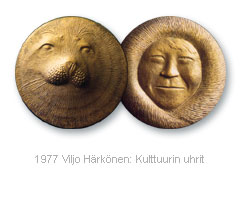
http://mitalitaide.fi/in-english/

